SAINT LOUIS ZOO ASSOCIATION
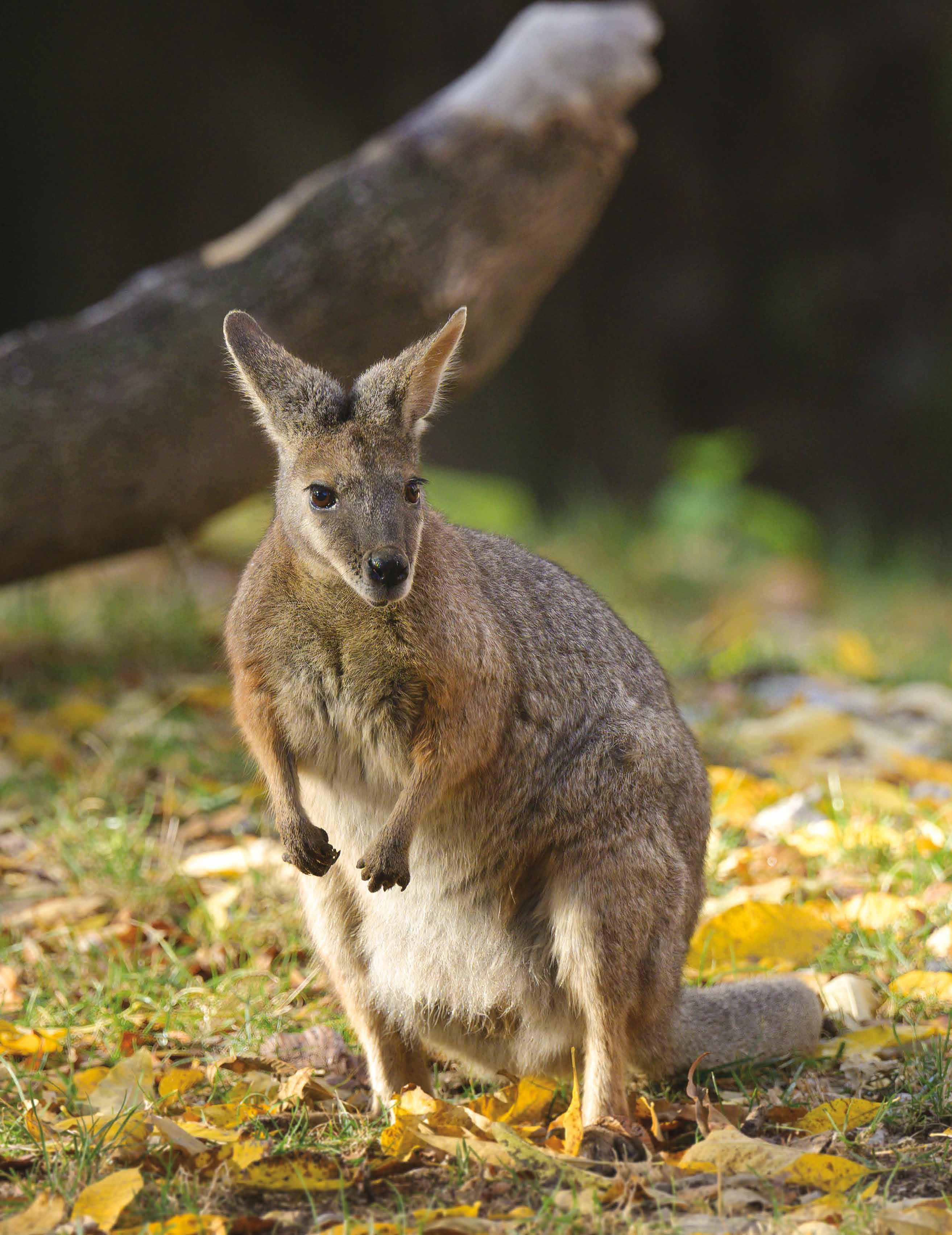 The Lonely Hearts Club | Answering the Call of Duty: Swing Keepers | Composting 101
The Lonely Hearts Club | Answering the Call of Duty: Swing Keepers | Composting 101
Winter 2023 Volume 39, N0. 1
By Dwight Scott, Dana Brown President & CEO, Saint Louis Zoo
Happy New Year! I hope you and your loved ones had a happy and healthy holiday season.
Winter at the Saint Louis Zoo is one of the best times for a calm, reflective visit. While we love to see lots of guests excited to see the animals, a cold, quiet day at the Zoo allows for less distraction and more opportunity to really observe the animals. I hope you’ll take the opportunity to see us soon.
We admire all animals at the Saint Louis Zoo, and all are available for adoption through our Zoo Parents Program. There are some animals less frequently adopted than others, so for this issue’s cover story, we wanted to shine a spotlight on our “lonely hearts club.” Once you learn more about them, you’ll find how incredible they are! Maybe you or a loved one will find your new best friend at the Zoo?
The start of the new year can be time for change, however that may look like for you. For three of our keepers, change is a part of their everyday jobs. We have three dedicated animal care professionals, called swing keepers, who cover shifts for other keepers who are out for family or medical leave, injury or fieldwork. They could be called at a moment’s notice to work in a new department with new animals. In our story on Page 12, learn more about their unique roles and their dedication to animal care.
Speaking of a time for change, how about New Year’s resolutions? Now is a great time to consider some resolutions for better sustainability and planetary health, like composting! On Pages 18 and 19, read our “Composting 101” story, which will get you started on creating healthy soil and lowering your carbon footprint. For your young ones, we also have an introduction to composting on our kids page, and our infographic on Page 3 includes even more “green” resolution ideas!
One of our biggest conservation success stories in 2022 was the release of our 10,000th hellbender. Since 2008, our team has raised hellbenders in human care, preparing them for eventual release into Missouri rivers. This is an incredible partnership between our Zoo team, the Missouri Department of Conservation and the U.S. Fish and Wildlife Service. Read about this milestone on Pages 20 and 21 from the newest leaders of our Zoo’s herpetology team.
Although January through March is a quieter time in terms of activities and events, there’s a lot to pencil into your calendar! One of the most beloved is St. Louis Children’s Hospital Make Tracks Through the Zoo, which will be Sunday, May 21. Start training now and register soon; this 5K event is incredibly popular and sells out fast.
As always, thank you for supporting the Saint Louis Zoo. stlzoo
COMMISSION OF THE ST. LOUIS ZOOLOGICAL PARK SUBDISTRICT
Chair
Cynthia J. Brinkley
Vice-Chair
Lawrence E. Thomas
Co-Treasurers
Chonda J. Nwamu
Lawrence E. Thomas
Immediate Past Chair
Winthrop B. Reed III
Commissioners
Karl A. Grice
Robert R. Hermann, Jr. Jerald L. Kent
Robert F. O’Loughlin
Neal F. Perryman
Michael W. Riney
Peggy A. Ritter
Steven C. Roberts
Will R. Ross, MD, MPH Carol A. Wilson
Chairs Emeritus Honorable James F. Conway
Steven F. Schankman
Mark J. Schnuck
SAINT LOUIS ZOO ASSOCIATION BOARD OF DIRECTORS
President Alicia S. McDonnell
Vice President
Robert B. Smith III
Treasurer James E. Williams, Jr. Secretary
Michael J. Hickey
Immediate Past President John R. Sondag

Executive Committee
Caryl L. Flannery
Pamela A. Glaser
Charles Henson
Mark W. Hubbert
Linda J. Hunter
Molly Hyland
Kenneth A. Johnson
Dr. Matthew R. MacEwan
Melissa Markwort
Jennifer T. McGrath
Lisa W. Nouss
Thomas P. Pollihan
Angela D. Schaefer
William R. Schmidt Heather Wood
Board of Directors
Susan S. Block
Cenia D. Bosman
Christine Boushka
Dr. Edmond B. Cabbabe
Mary B. Campbell Debbie A. Caplin
Karen L. Condie
Hazel Alethea R. Donald
Edward Durham
Brad M. Edwards
Cory Elliott Kathy S. Federico
Logan W. Finerty
Lauren Thomas Fries
Matthew W. Geekie
Amy A. Gill
Brett G. Gilliland
Janis G. Goldstein
Davida Lichtenstein
Grindstaff
Kenneth H. Hannah
Ricky L. Hopkins, Sr.
Ryan L. Hyman
Robert F. Johnston
Carol S. Klein
Lee C. Kling
Judith B. Kouchoukos
James P. Leonard
Julie Lilly
Sarah London
Dr. Dan W. Luedke
Ryan J. Martin
Anna McKelvey
John F. Meara
Julia Mize
Patrick J. Moore
Dr. Stanley J. Niemann
Bhavik R. Patel
Pravina Pindoria
Dr. Steven S. Pope
Dana Tucker Redwing
Stephen M. Reese
Quirsis V. Riney
James G. Sansone
F. Schankman
All lists as of November 2022
Steven
Shelley
Torbjorn
Lisa
Sullivan Dianne Sutcliffe Kevin Travers Virgil Van Trease Lottie
Matthew
Wagner Gerald
Wiley Robert
Williams, Jr. Emerita – Emeritus Members James G. Berges Marguerite Garrick Douglas E. Hill Joseph F. Imbs III John K. Wallace, Jr. Ex-Officio Katie Lineberry SAINT LOUIS ZOO YOUNG ADVISORY BOARD President Katie Lineberry Secretary Allycia Uhrhan Vice Presidents Whittney Dunn Samantha Hurrell Megan Schwedtmann Kim Sonderman Luke Yamnitz Treasurer Brittany Mayfield Liaisons Meghan Haines Jennifer Jeffries Rei Kato Tre Moore Rob Patterson Mike Poletti Phil Posley Zach Ungerott Eric Werner Board Members Erica Agnew Jason Berg Alexander Burkart Ashanti Carey Emily Carter Praveena Kolli James Merenda Timothy Nielsen Lauren Parko Dacoda Scarlett Kristin Shannahan Kelly Stein Justavian Tillman Michael Tulley Christian Wargo PROFESSIONALS
Seifert Ashish Sinha
B. Sjogren
K.
Wade
A.
E.
M.
Commentary
In This Issue
6
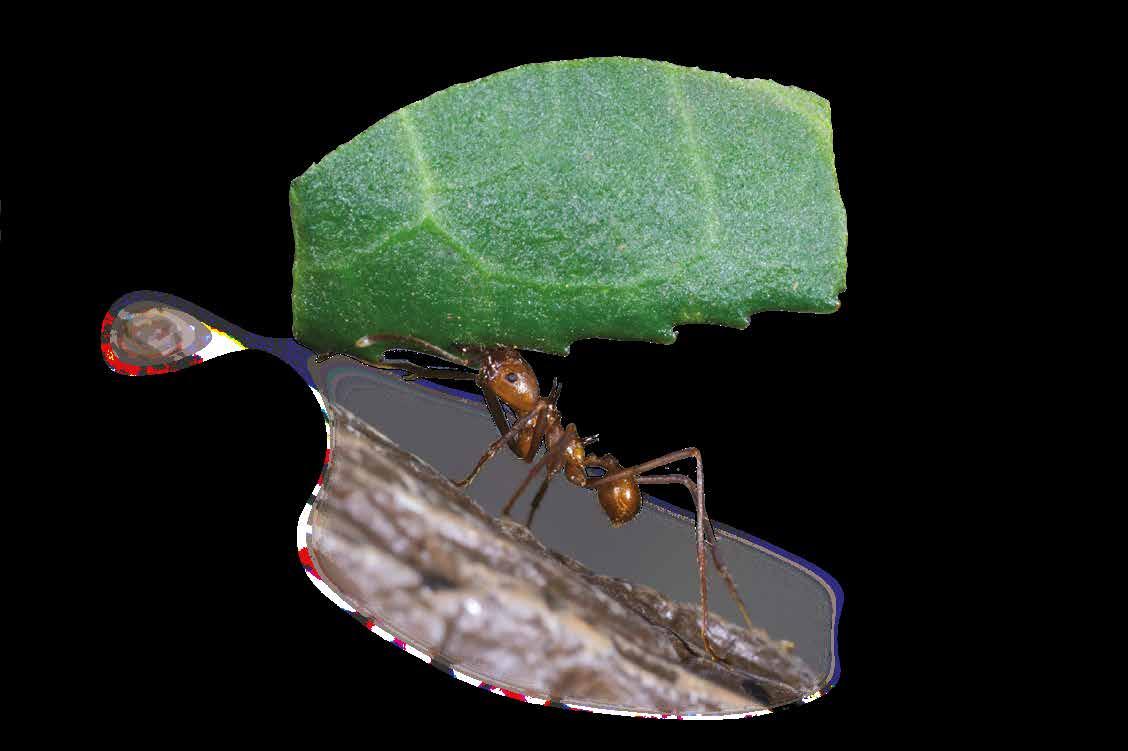
The Lonely Hearts Club
All animals are adoptable through the Zoo Parents Program, but some aren’t adopted as much. Learn more about them, and maybe you’ll find a new Zoo love!
12
Answering the Call of Duty: Swing Keepers They are keepers who cover shifts for colleagues across all Zoo departments. Find out more about their unique roles.
18
Composting 101 Ever wanted to try composting but didn’t know where to start? Here’s your beginner’s guide!

On the Cover Wallaby Photo by Ray Meibaum
stlzoo is published quarterly as a member benefit by the Saint Louis Zoo Association, One Government Drive, St. Louis, MO 63110. Permission to reprint any material is granted, provided proper credit is given.
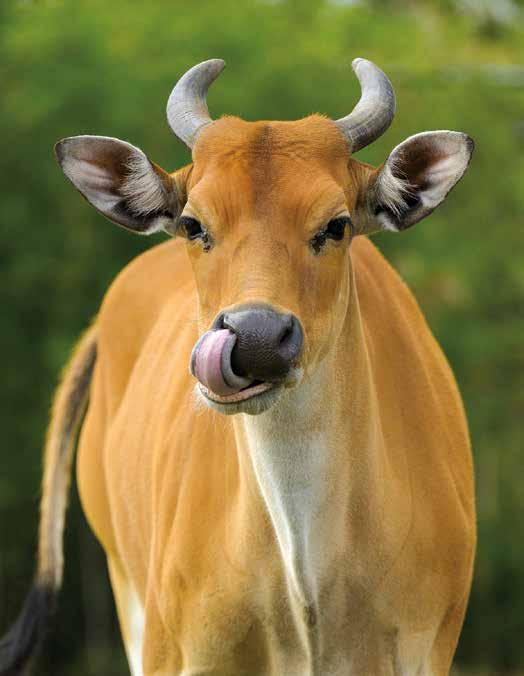
n Managing Editor: Rebecca McMiller
n Editorial Assistance: Billy Brennan, Jill Gordon, Kirby Meyer, Elaine Vydra
n Graphic Design: McCord Design Group
n Contributing Photographer: Ray Meibaum
n Contributors: Members of the Zoo staff
At the Saint Louis Zoo, we not only care about the conservation of animals, but also about the conservation of the environment. That is why stlzoo magazine is created using FSC- (Forest Stewardship Council) certified paper with recycled materials and eco-friendly inks.
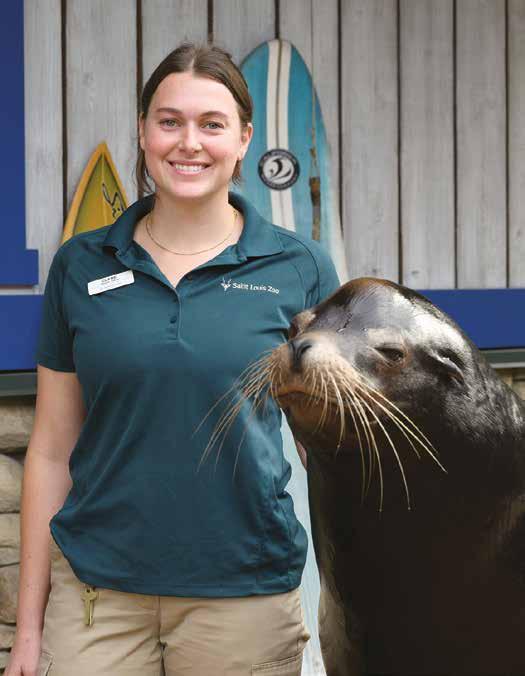
1 Winter 2023
2
2
22
29
30
32
Membership Matters
Zoo Young Professionals Rumble
Happenings
Saint Louis Zoo Honor Roll
Saint Louis Zoo Tribute Fund
Kids Page
Leafcutter ant
Membership Matters
By Lucia Clifton, Director of Membership
Happy New Year! Winter is a fabulous time to visit the Zoo; it’s quieter and you can really take your time to see the animals. Be sure to come by and take advantage of your member benefits!
As you prepare for tax season, don’t forget that your Zoo membership is tax deductible. Visit stlzoo.org to learn more; tax information is provided as part of the Frequently Asked Questions under the Membership tab.
You already know your membership allows you to enjoy the Zoo all year long, but did you know that our Zoo Parents Program is another great opportunity for support? When you become a Zoo Parent, your donation goes toward the animals’ care and daily feeding. For example, our family of elephants receives over 500 pounds of hay a day. Our penguins and sea lions consume 4,000 pounds of mackerel and 5,000 pounds of herring each year. All animals are available for adoption — including our “lonely hearts club” members (see article on Page 6). Whatever animal you choose, you not only gain
a new family member, but your donation helps take care of our animals.
And if you’re looking for a great gift for that special valentine, seal it with a kiss! A harbor seal adoption will let your sweetheart know they are loved all year long. This special Valentine’s Day adoption package includes a 12” harbor seal plush toy, personalized Certificate of Adoption and much more. It makes a one-of-a-kind gift! To learn more, visit our website, check your mailbox or click on the email link for detailed information about our harbor seal adoption.
Whether this is your first year as a member or you’ve been a decades-long member, we appreciate your commitment to the important work we do here at the Zoo and around the world. Your membership makes a difference. n
Please bring your membership card with you on each visit to the Zoo to enjoy your free parking and attraction benefits. Please note: If you visit without your card, you may retrieve your member tickets at either Welcome Desk; however, tickets cannot be retrieved at attractions.
Zoo Young Professionals Rumble Young Professionals in their 20s and 30s
By Katie Lineberry, President, Zoo Young Professionals (ZYP) Advisory Board
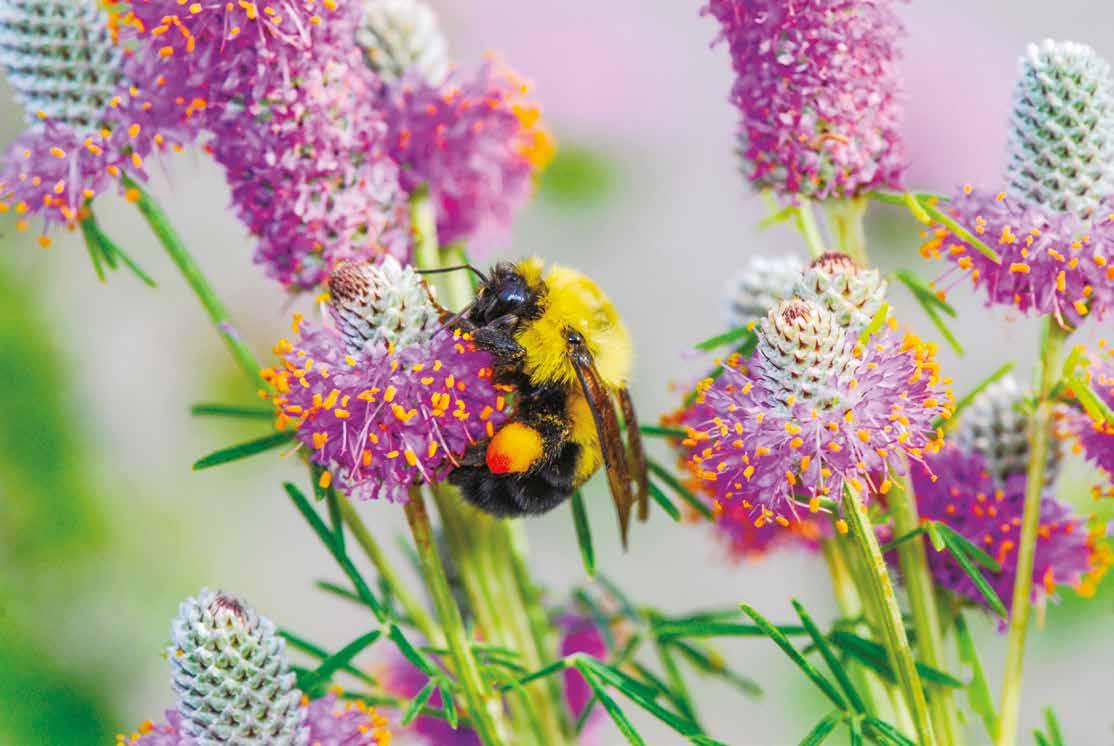
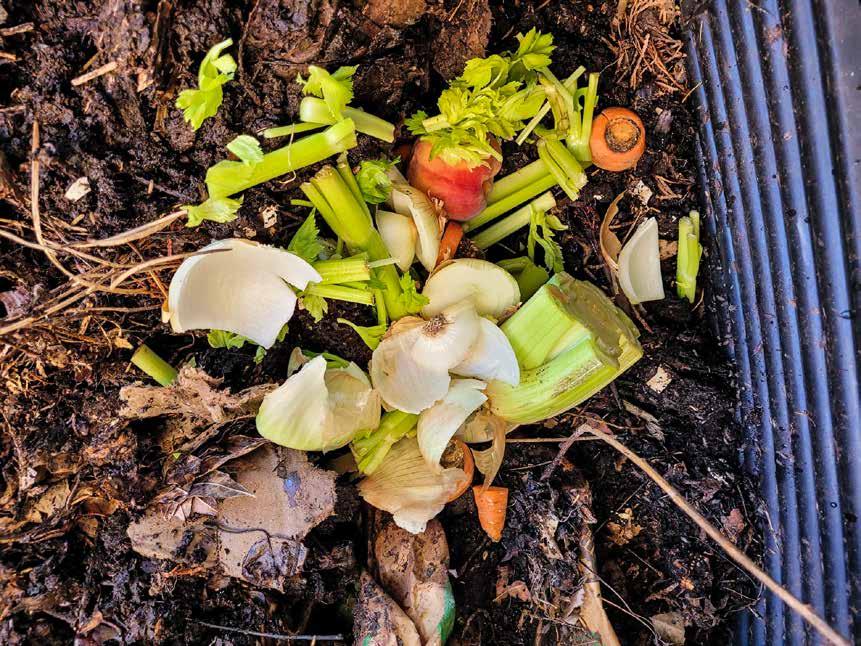
Looking back at 2022, it was a great year for Zoo Young Professionals. Jammin’ at the Zoo returned for the first time since 2019, and it did not disappoint! The beer and wine tastings, exclusive ZYP member lounge and the band FatPocket kept the party going all night.
During the holidays, U.S. Bank Wild Lights provided many opportunities for friends to get together. The spectacular light displays included 580 illuminated trees! Plus, many members enjoyed s’mores by the fire pits and holiday-themed cocktails, made even sweeter with the member discount!
Jammin’ at the Zoo will be back in 2023 with events in July and August! Your ZYP membership includes two free tickets
for each event, so be sure to renew so you don’t miss out. More information will be available in the coming months.
Any way you look at it, being a ZYP member has so many great benefits. You get to enjoy the Zoo during the day with free parking and member tickets, and you receive discounts to select evening events. Your membership supports the Zoo’s conservation efforts, and you can have fun doing it! Encourage your friends to become members, too.
Are you in your 20s or 30s and interested in receiving invitations to ZYP events? Even if you’re a member at any other level, we’ll add you to the list. Just send an email to membership@stlzoo.org. n
stlzoo 2
Greener 5 Tips for a New Year
New Year’s is a great time to prioritize green living. Our actions add up! Consider ways that you can reduce your energy, water and waste footprint. By treading lighter on the planet in our personal and collective lives, we help animals locally and around the world.
1.
Reduce Light Pollution
Birds, bats, insects and even humans need night time to live healthy lives. Birds use stars to navigate when they migrate. Insects need darkness for camouflage and mating signals. Excessively bright lights contribute to light pollution. When you need to use outdoor lights (warm-colored bulbs are best), point downward and use timers or motion sensors.
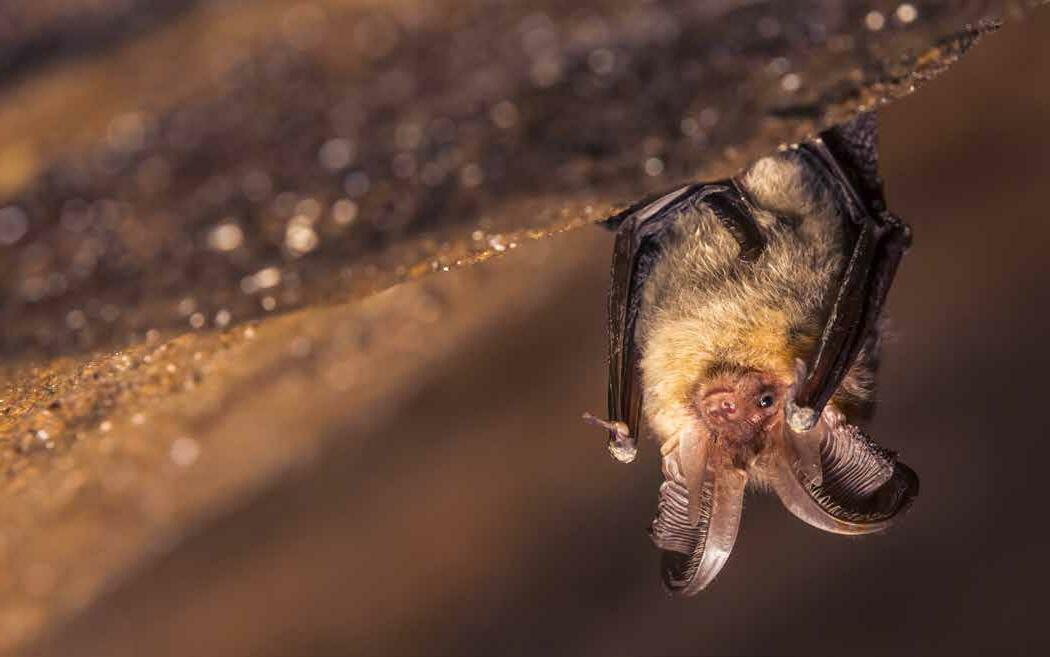
2. Plant Native for Biodiversity Native, perennial and pollinator-friendly plants serve many roles that bene t wildlife. Perennial plants have deeper roots, which make them drought-tolerant and help them absorb more carbon dioxide.

3. Reduce Single-Use Plastic
Go on a plastic diet! Think about what you can eliminate from your daily life. Use reusable water bottles and grocery bags, and avoid straws. Purchasing in bulk reduces packaging.

4. Compost at Home Composting reduces waste sent to land lls and cuts down on methane emissions, a greenhouse gas much stronger than carbon dioxide. Compost is nutrient-rich food for your garden, too.

5. Be Wise About Water
Water is a precious resource, even in the Midwest where it is plentiful. Reduce water use with e cient xtures, use rain barrels to water plants and take shorter showers.

FUN FACT:
Where Does the Zoo Get Browse?
Ameren Missouri regularly prunes trees that threaten power lines.

Ameren Missouri delivers truckloads of tree trimmings to the Zoo for the animals. We also partner with Bellefontaine Cemetery, which provided the Zoo land on which to grow trees and offers harvesting opportunities for existing trees. We’re thankful for these partnerships!
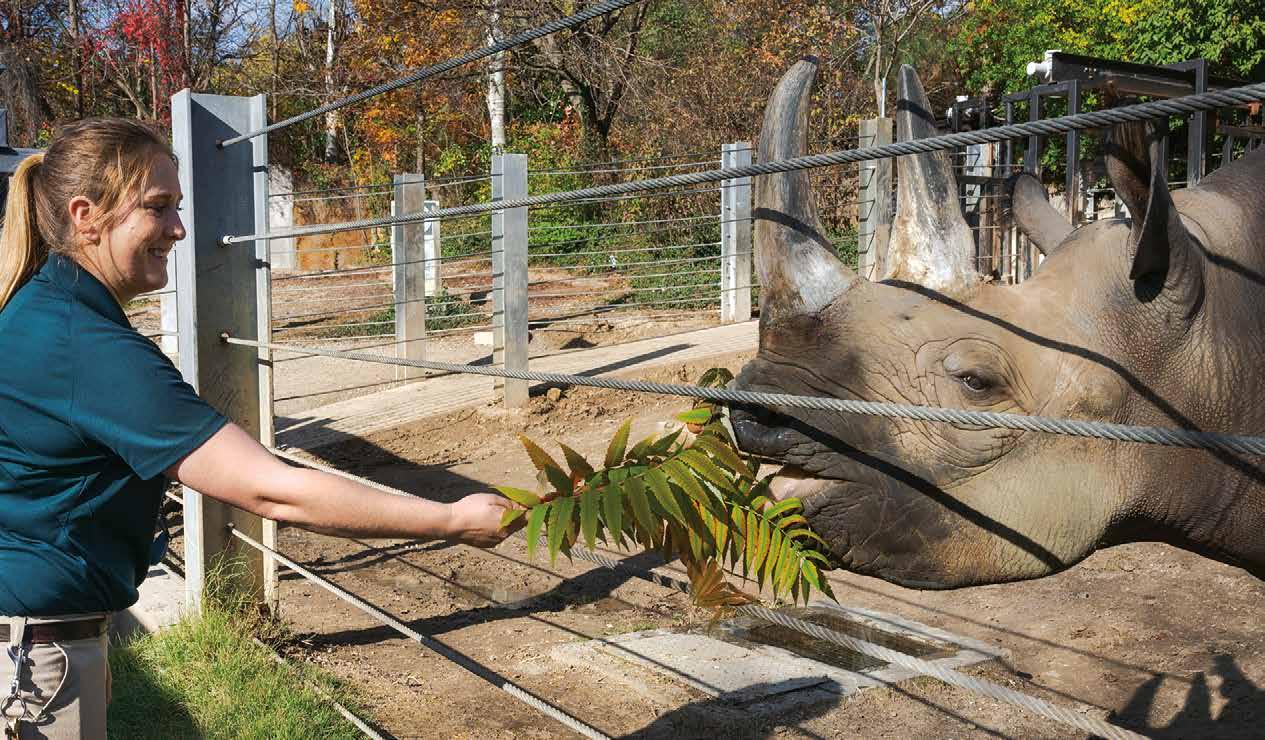
1
Did You
Browse, or tree trimmings, is very important for many animals’ diets. Just like how you may freeze food to save for later, the Zoo does the same thing for browse! Our animal care team freezes fresh browse to be used in the colder months when greenery is scarce.
Browse (tree trimmings) is delivered to the Zoo
stlzoo 4
Swing Keeper Holly Simmons feeds browse to a black rhinoceros
Where Does the Browse Go for Freezing?
Located in River’s Edge, the giant freezer in the Orthwein Animal Nutrition Center holds 300 large containers of frozen browse. The frozen browse contains branches from willow, mulberry, elm, ash and hackberry trees.
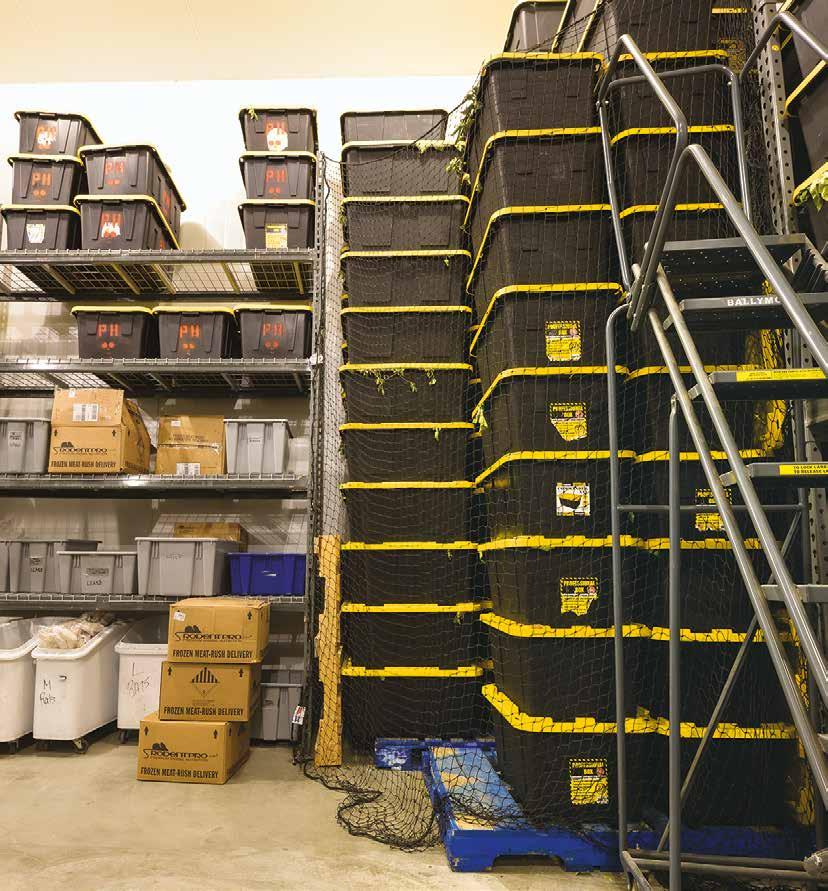
What Animals Eat Browse?
Great apes, elephants, takin, rhinos, giraffes and tortoises are just some of the animals that eat browse. Browse contains vitamins, minerals, and most importantly, fiber.
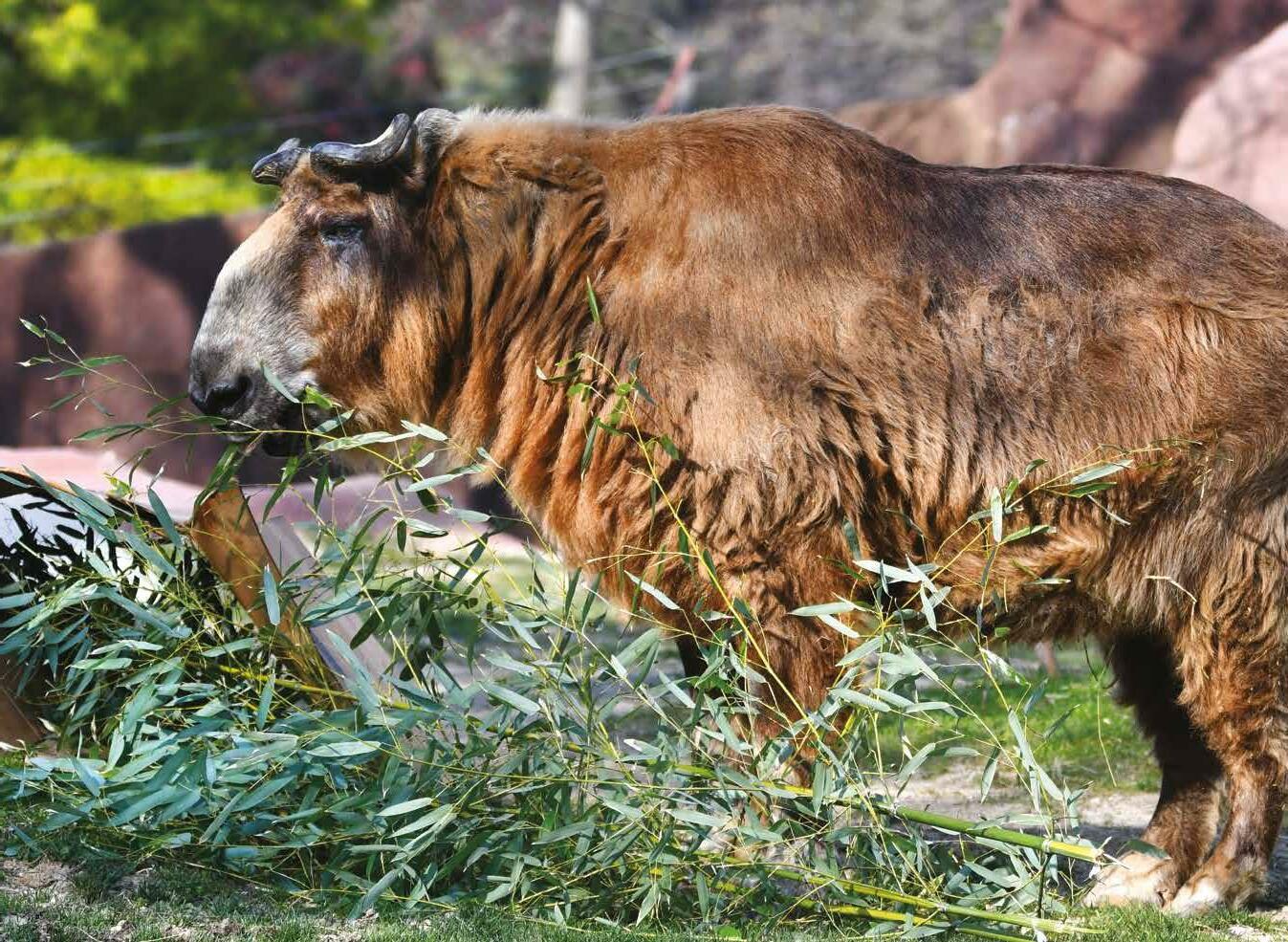
3
Know... 2
LEARN MORE about how we care for animals at stlzoo.org
Frozen browse is stored at the Orthwein Animal Nutrition Center
5 Winter 2023
A Sichuan takin enjoys some fresh browse
By Ruth Dultz, Assistant Manager, Interpreters, and Megan Froemling, Lead Interpreter;
Photos by Ray Meibaum and Robin Winkelman
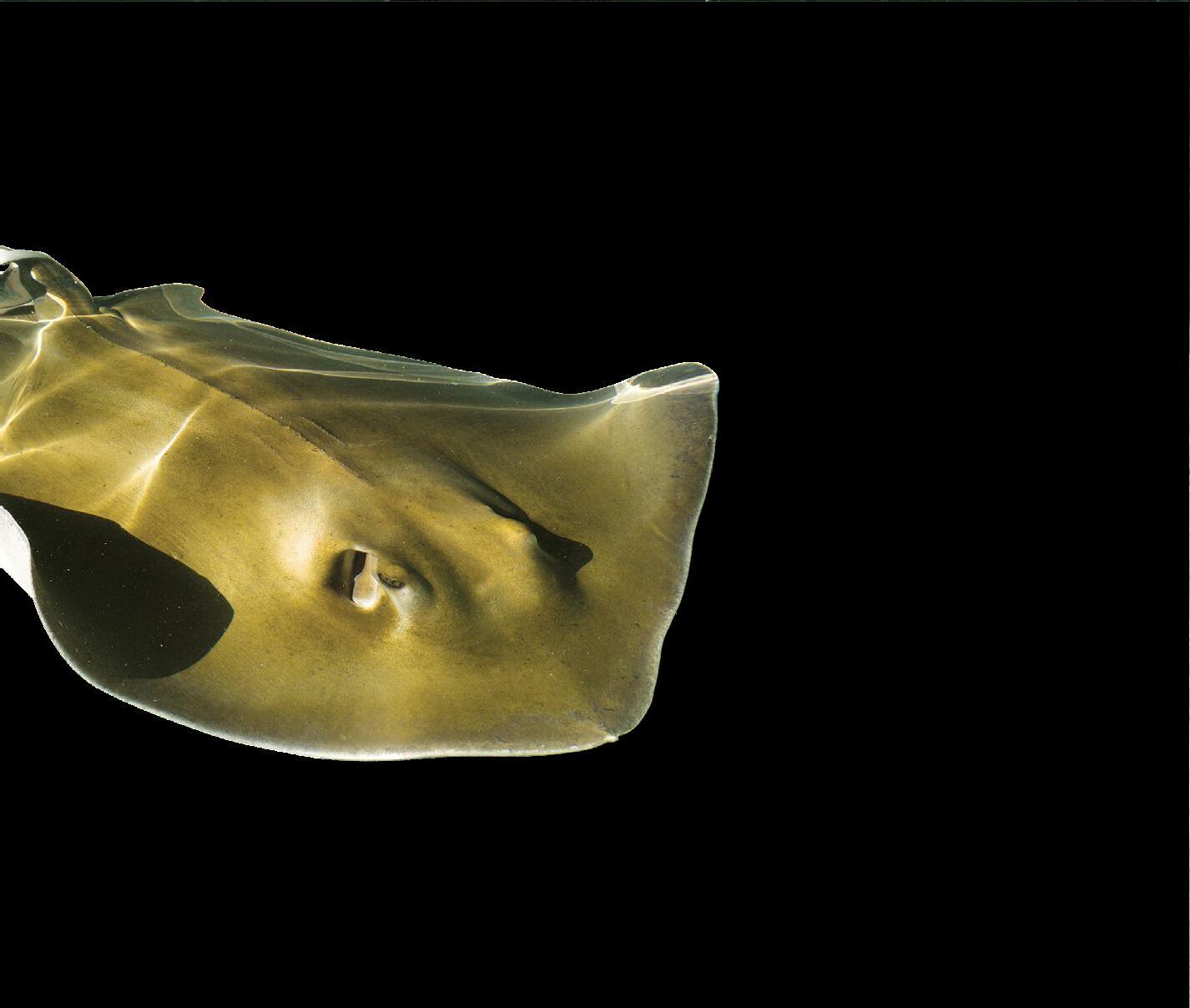
STL ZOO
TheHeartsLonelyClub
SPEKE’S GAZELLE
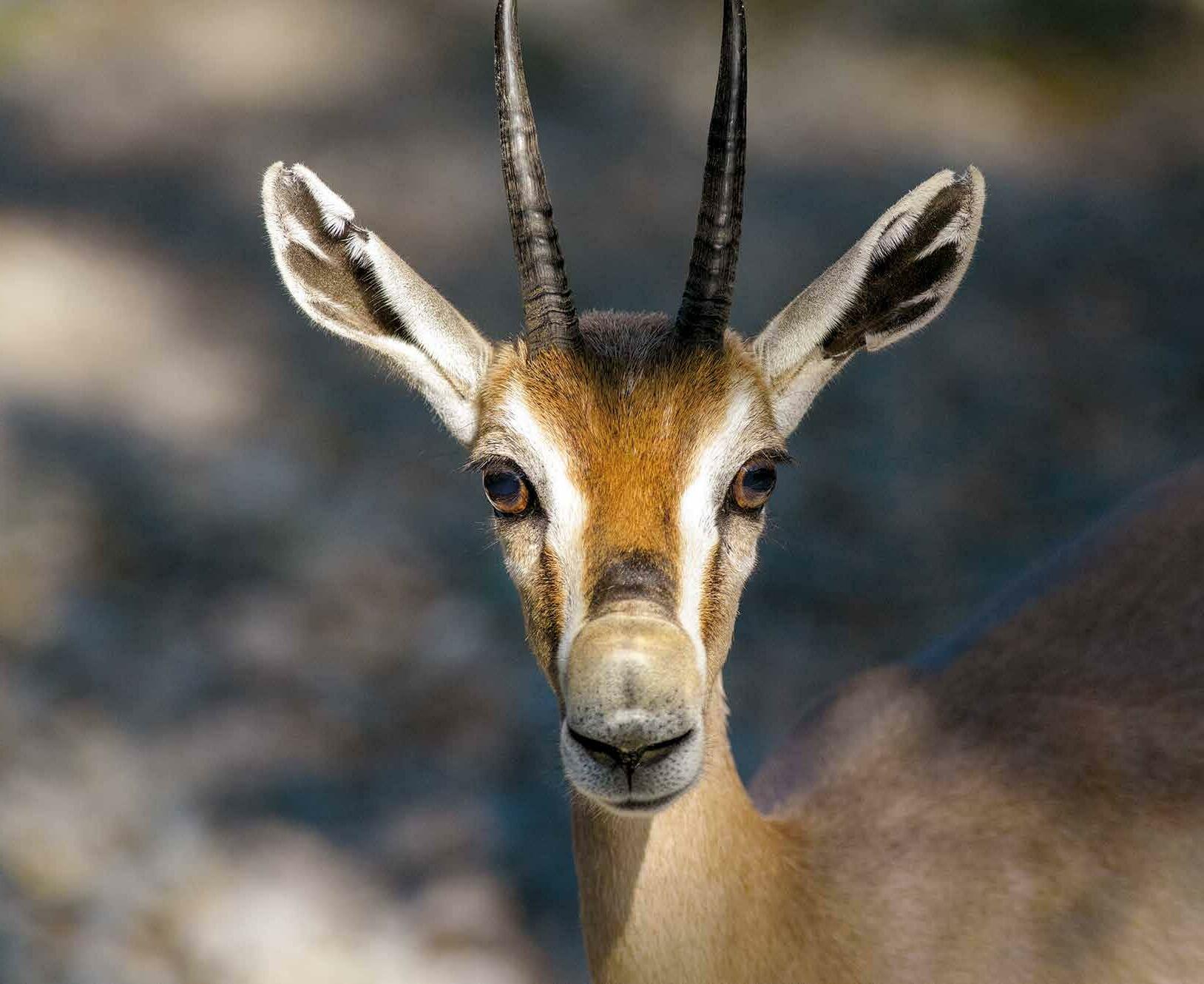

HORNED GUAN

e admire and appreciate all the fascinating animals at the Saint Louis Zoo. You can adopt any of them through the Zoo Parents Program, and your donation helps provide for their care and feeding for a whole year. There are some animals, however, that aren’t adopted as much … we’ve lovingly dubbed them the “lonely hearts club.” But these animals are more unique than you may think! Check them out, learn a little more about them … and maybe you’ll find a perfect match and forever friend!

7 Winter 2023
STL ZOO
A Love Letter...
Roses are red, violets are blue, It’s party time at the Saint Louis Zoo.
A few lonely hearts attempt to make a connection, Each hoping to leave a lasting impression.
What’s a party without proper attire?
The horned guan’s fancy hat is on fire!
The Guam kingfisher is dressed to thrill, With metallic wings and strong, sharp bill.
Leafcutter ants arrive on the scene, Carrying flowers to please their queen. Speke’s gazelles hop in, nose flaps poppin’.
The joint is jumping, these guys are rockin’!
Wallaby hops along to the beat, Hoping the banteng doesn’t step on his feet. Southern stingray doesn’t dance much, at all. She’s quietly hanging out, alone by the wall.
Cinereous vulture arrives fashionably late, Hopefully someone saved him a plate!
The lonely hearts club revels the night away, Still looking for some extra love someday.
Bg

You haven’t “herd” of the banteng? Not too surprising as these bovine beauties can be shy and maintain a nocturnal lifestyle when humans are around. Considered one of the most graceful of the wild cattle, the adult males sport a dark blue-black coat, and the females and young don lighter chestnut coats. Banteng adults have white rumps and white socks on all four legs. Native to southeast Asia, banteng graze in green forests and grasslands. Grazing time is social hour; banteng gather in groups of up to 30 cows. You know you are one of the gang when another banteng gives you a kiss! It’s no bull; these cows lick one another to strengthen bonds in the herd. When the mooo-d strikes, you can visit the banteng in Red Rocks.
If you like eating fruit and flowers and getting caught in the rainforest, escape with the unique and captivating horned guan. Horned guans get their name from the bright red horn on the top of their heads, which actually starts as two bumps that twist and grow together. These turkey-sized birds enjoy the high life, living among the trees in the mountains of Mexico and Guatemala. If you like coffee grown on hillsides in the shade of the trees, you’ll find the horned guan there. If this is the bird that you’ve
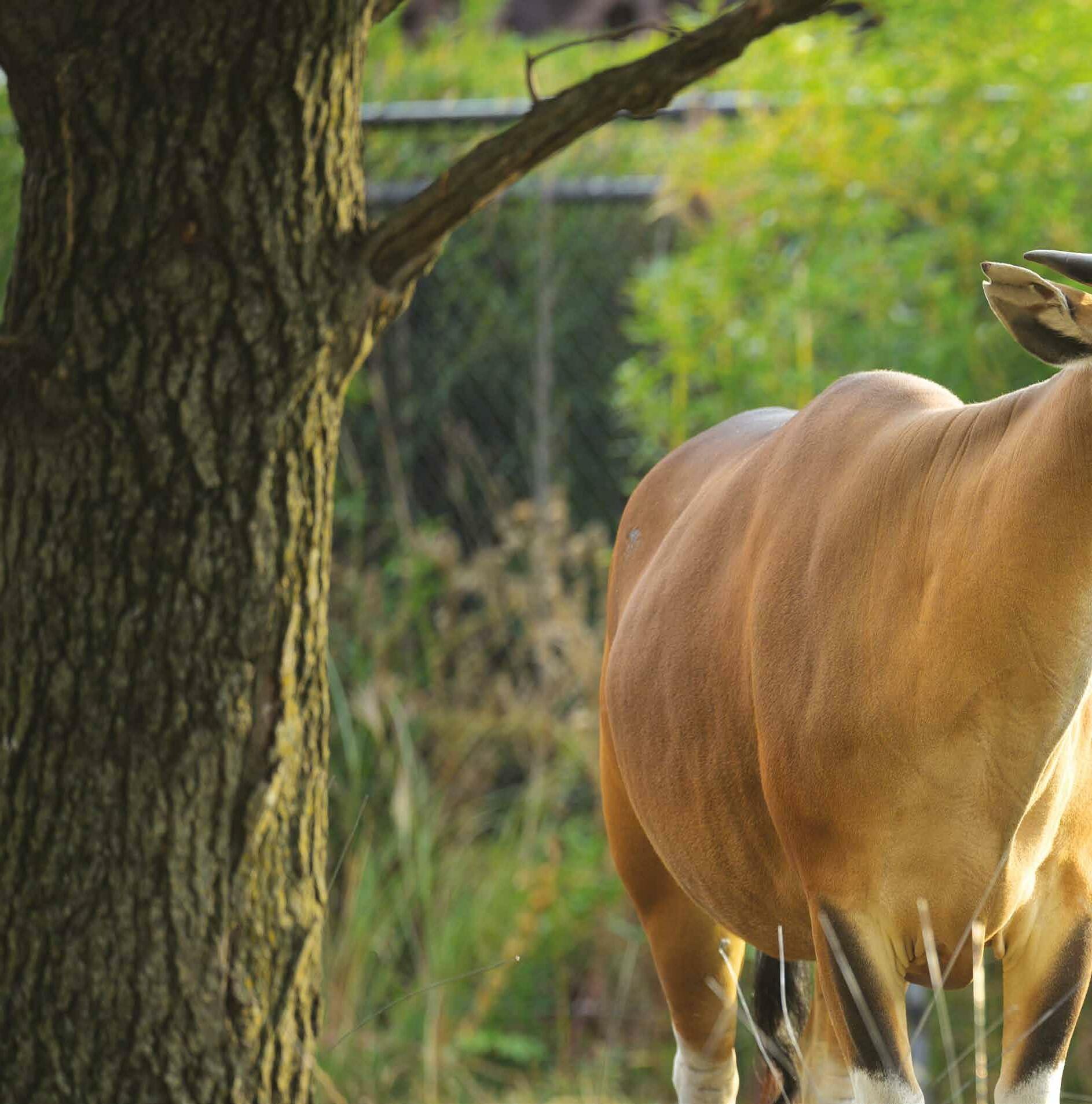
stlzoo 8
SPEKE’ S GAZELLE
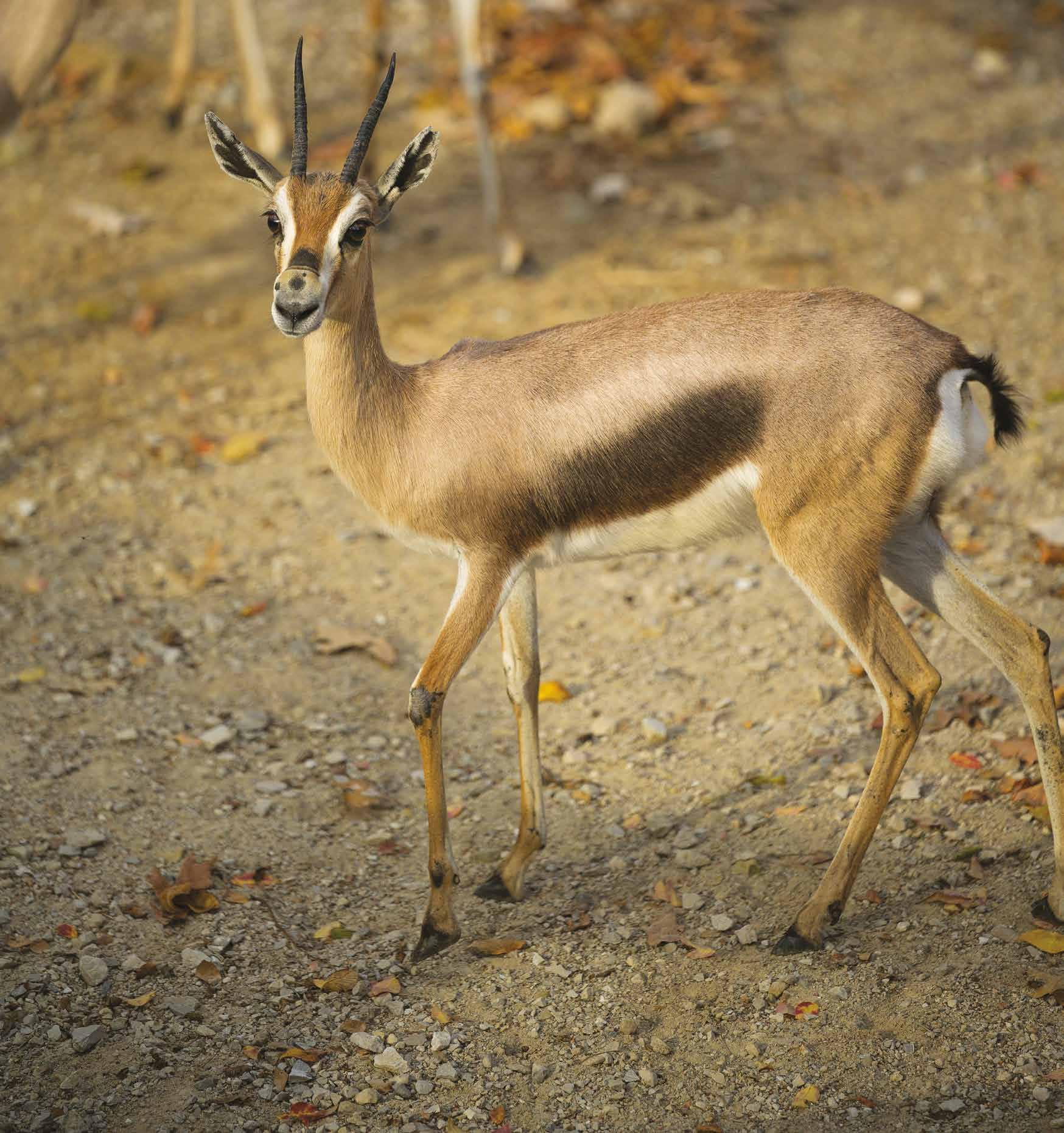
her
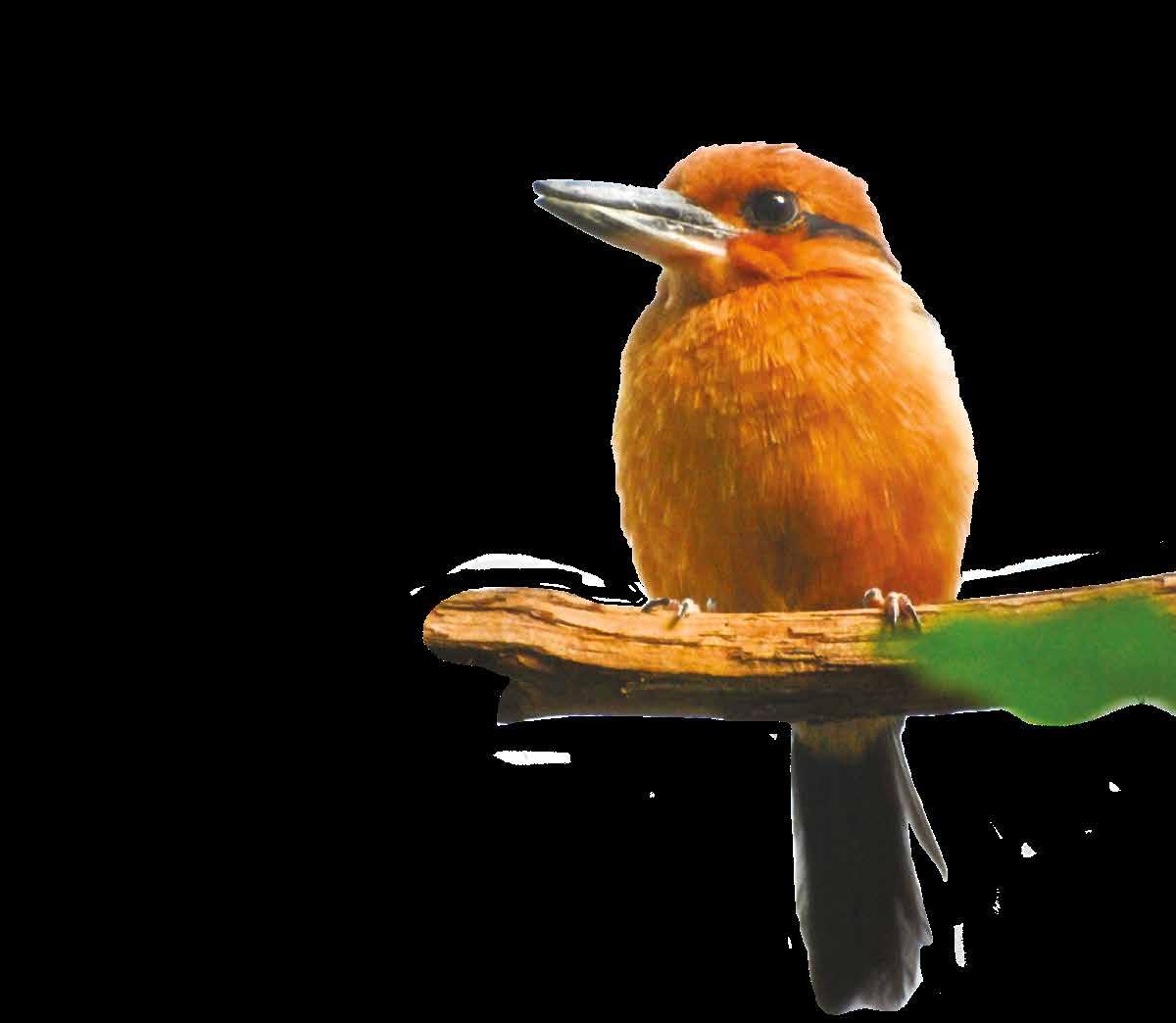

BANTENG
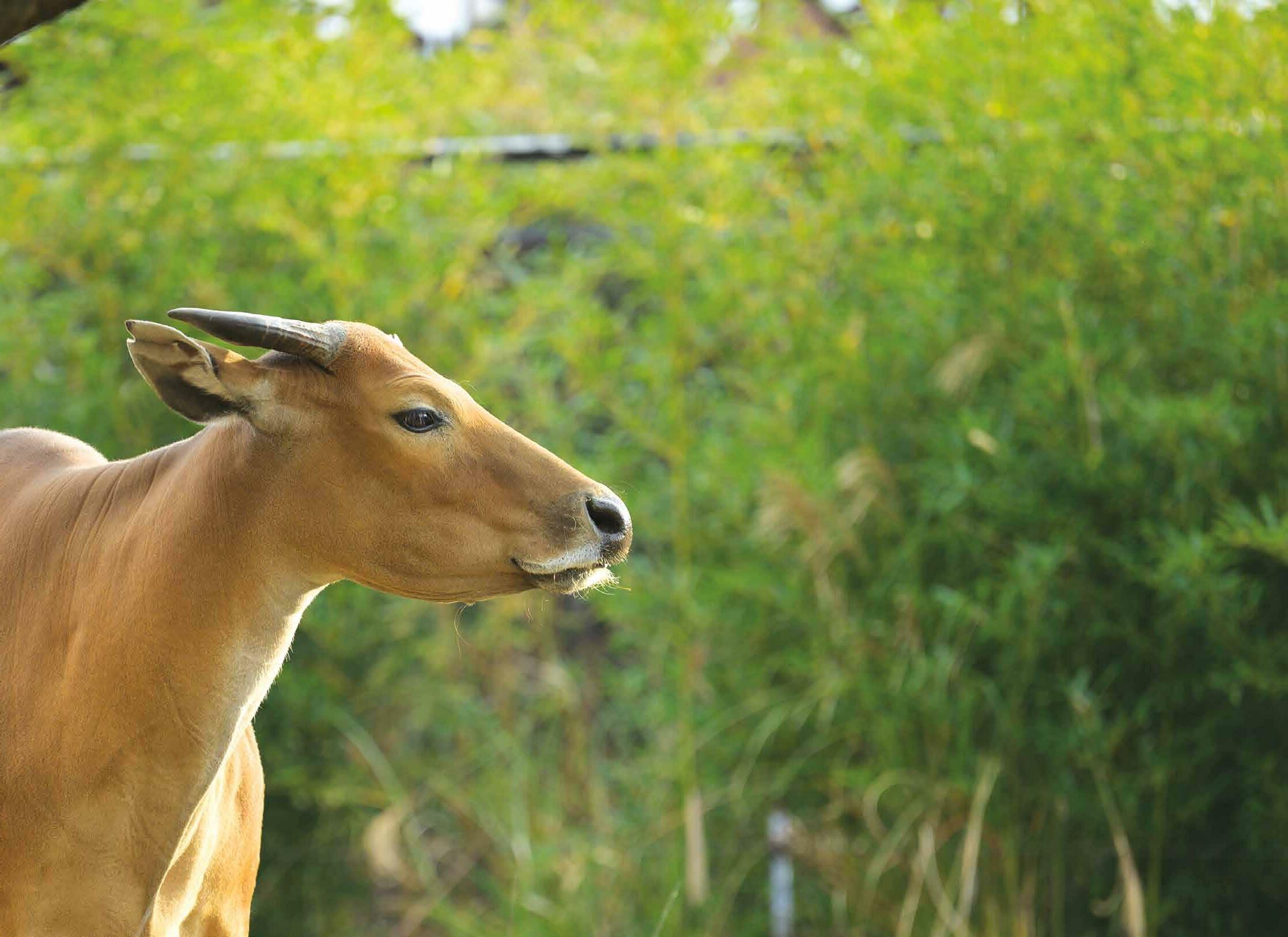
Guam kingfishers are extinct in the wild and can only be found in human care. With its unimposing size (think “robin”), the Guam kingfisher is easy to overlook. But what these colorful birds lack in size, they make up for in strength and appearances. Both males and females sport metallic blue-green wings and blue tails, with a cinnamon-colored head. Strong beaks allow Guam kingfishers to carve out nests in tree cavities. No worries about the housing market; they will make their own home! And if you need even more reason to admire these feathered friends, Guam kingfishers reliably call the same time each morning, leading to the belief that the birds can be used to tell time. Will this early bird get your heart? 9 Winter 2023
SOUTHERN STINGRAY
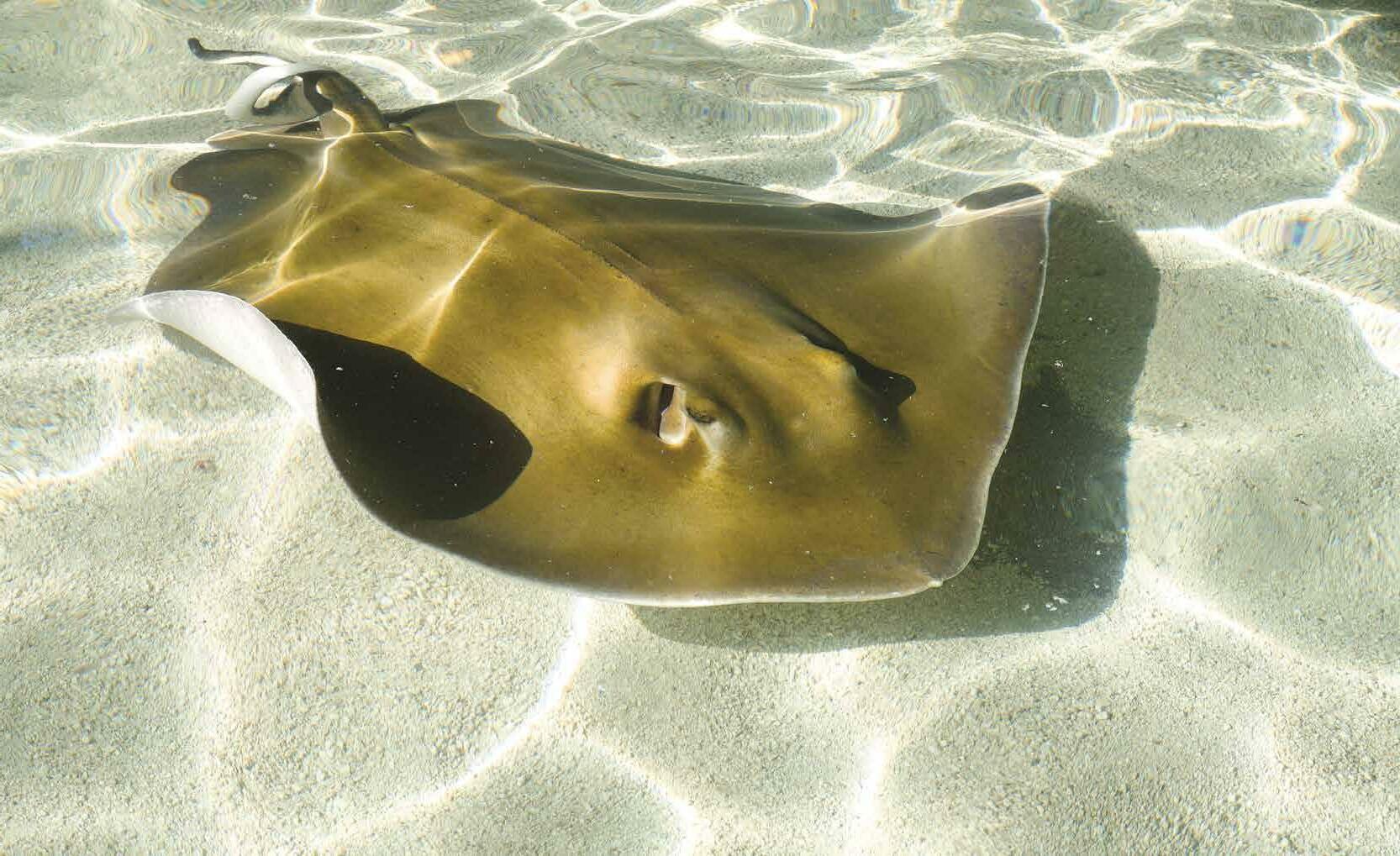
Sohern
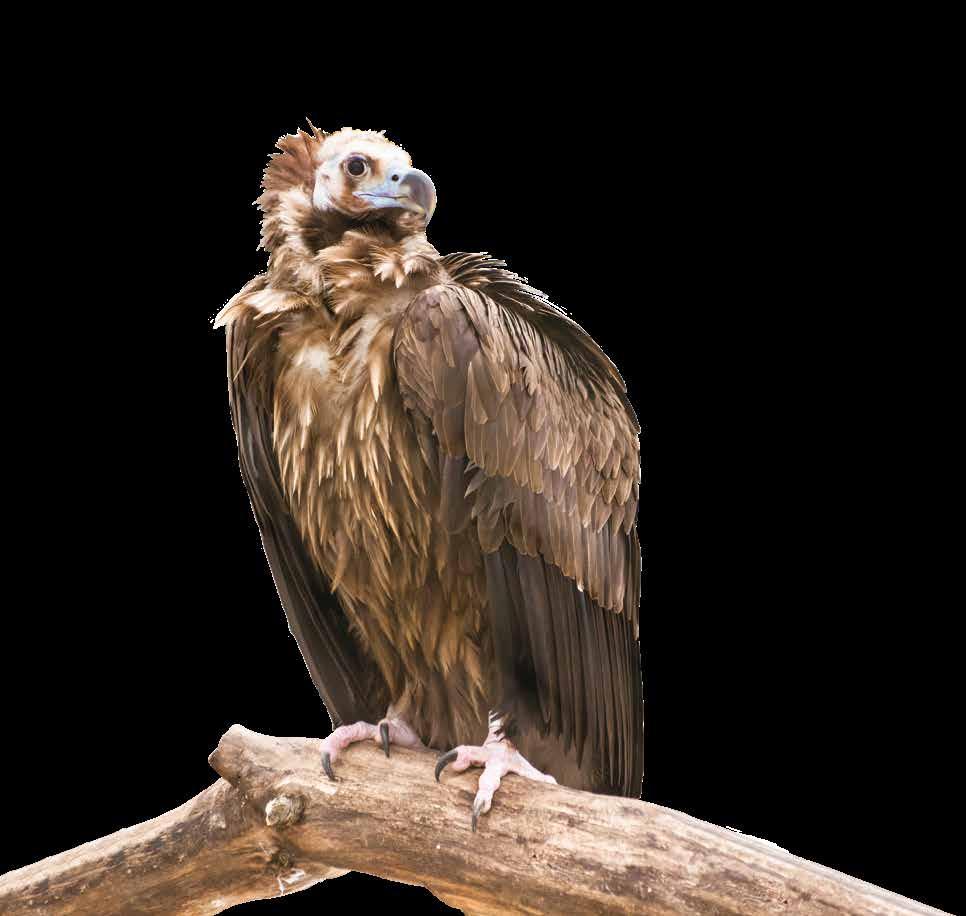

Snay
You might think the southern stingray would lead with a stinger, but this gentle giant prefers a game of hide-and-seek. Southern stingrays can grow to be 4 to 6 feet wide and would rather hide under a blanket of sand on the bottom of the ocean floor. They wait motionless for their prey of small fish and crustaceans, with only their adorable eyes poking out. A male follows the scent of the female and gives his sweetheart a little love bite to hold onto her while mating. The result? A litter of two to 10 dinner plate-sized, independent pups! If you’re looking for them on the beach, be sure to shuffle your feet. At the Zoo, no shuffling needed, as they are in the pool at Stingrays at Caribbean Cove presented by SSM Health in the spring through fall.
Leafcer As
You may work hard to avoid ants in our humid Missouri summers, but the leafcutter ants will win your heart as they carry flower petals to their queen! A colony of leafcutter ants includes the queen (who may live up to 14 years!) and millions of worker ants, all females. The ants don’t actually eat the leaves and petals, but they carry them to a garden where they grow a fungus to feed their young ones. When it’s time to form a new colony, the queen lays eggs that are males. Each male flies away with a new queen wannabe and a bit of fungus to start a new garden and colony!
It’s like their very own picnic!
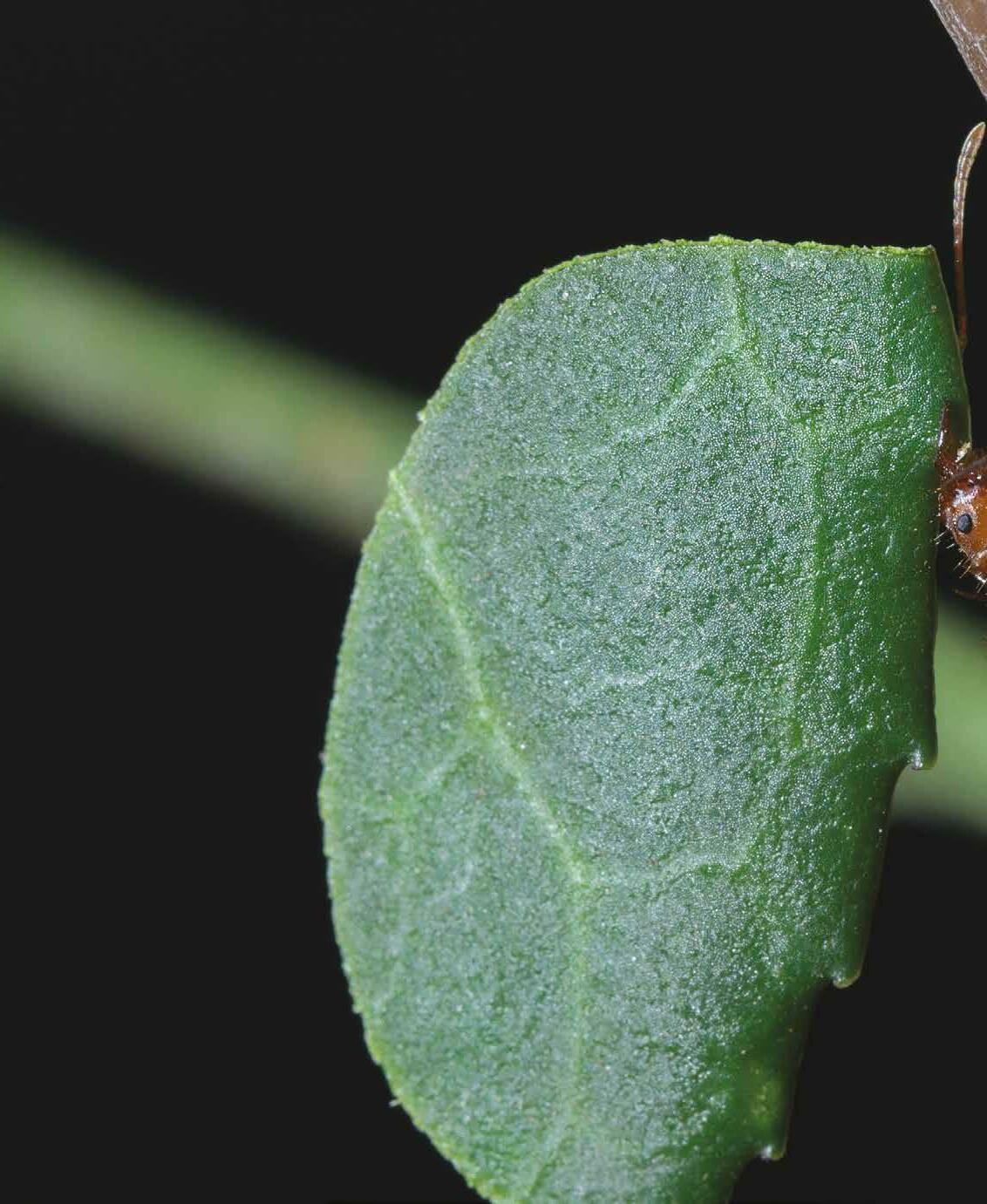
ANTS stlzoo 10
LEAFCUTTER
Cereous Vulte

Vultures are full of some pretty disgusting behaviors — and a face only a mother could love (or perhaps you?). But did you know that these amazing birds are one of the largest vultures and, in flight, resemble a small plane? Cinereous vultures mate for life and together build a monstrous nest that they return to each night throughout the year. There is a huge parental investment in nest building and raising a family. If you’re feeling a bit overwhelmed at the prospect of your own parenting, take a good lesson from the cinereous vulture. They pour everything into a single chick each year. Parents travel long distances during the day to find food, but they always return to the nest each night. Vultures are nature’s best cleanup crew and keep our planet healthy by eating carrion (dead and decaying animals).
Will You Show One of These Animals Some Love?

Become a Zoo Parent today and adopt a member of our lonely hearts club. Adopt for yourself, or an adoption makes a great gift for Valentine’s Day — or in celebration of our Zoo Parents Program’s 45th anniversary! You or a loved one may just find a forever friend at the Saint Louis Zoo. Learn more about the Zoo Parents Program at stlzoo.org/adopt.
ANTS
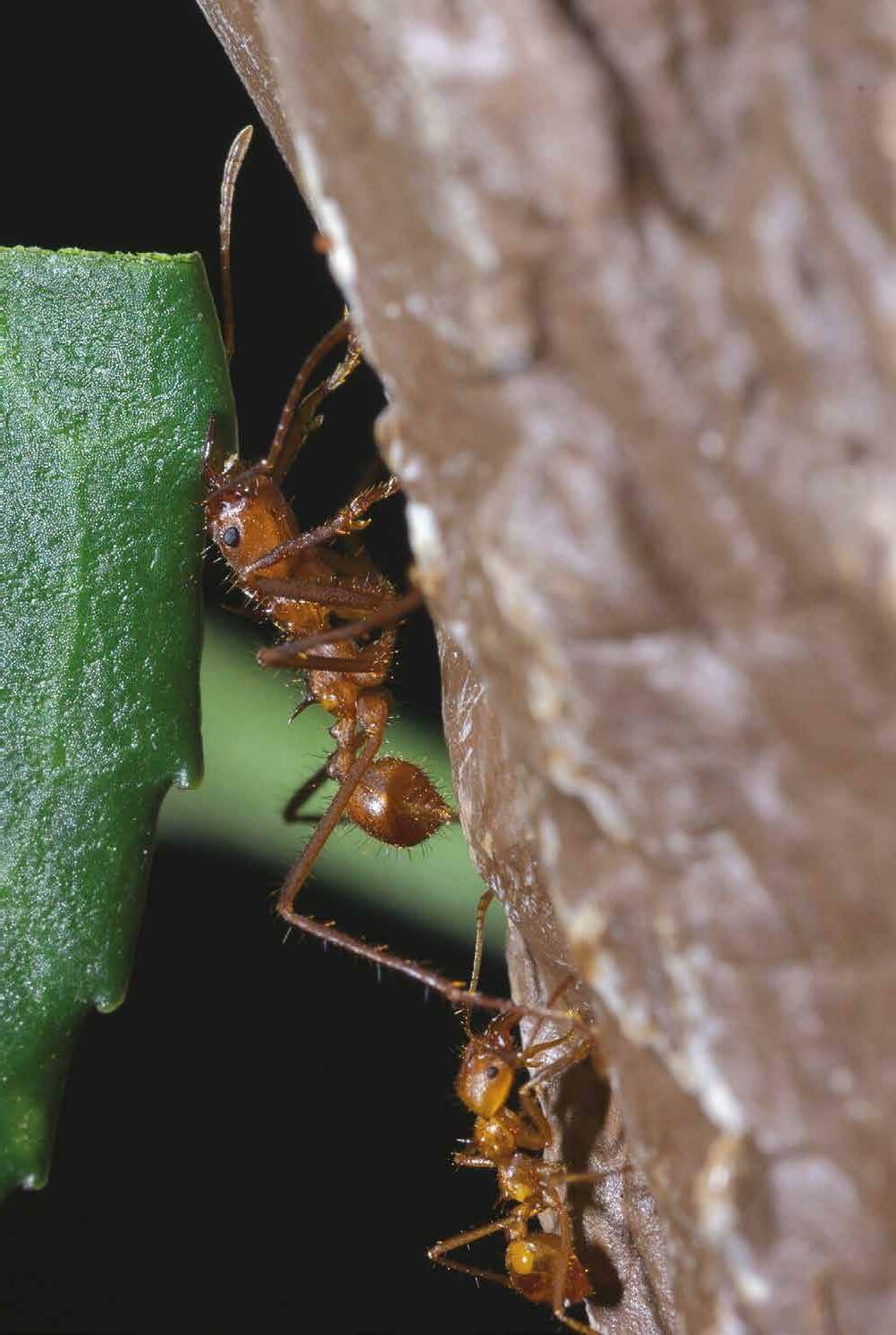
Waby
This tiny and shy cousin of the kangaroo could be easily overlooked if it weren’t for its cuteness quotient! Its adorable face and small stature make it a must-see on a Zoo visit. Like its cousin, a female raises a baby in its pouch. Wallabies are mostly nocturnal, coming out at night to forage for vegetation. Water may be scarce for them, so they get hydrated primarily from the food they eat. They also may drink small amounts of sea water. These little guys prefer to hang out in small groups; no big family gatherings for them! If you are shy and secretive and like to avoid crowds, you may just have some things in common with the wallaby!
11
Winter 2023
Answering the

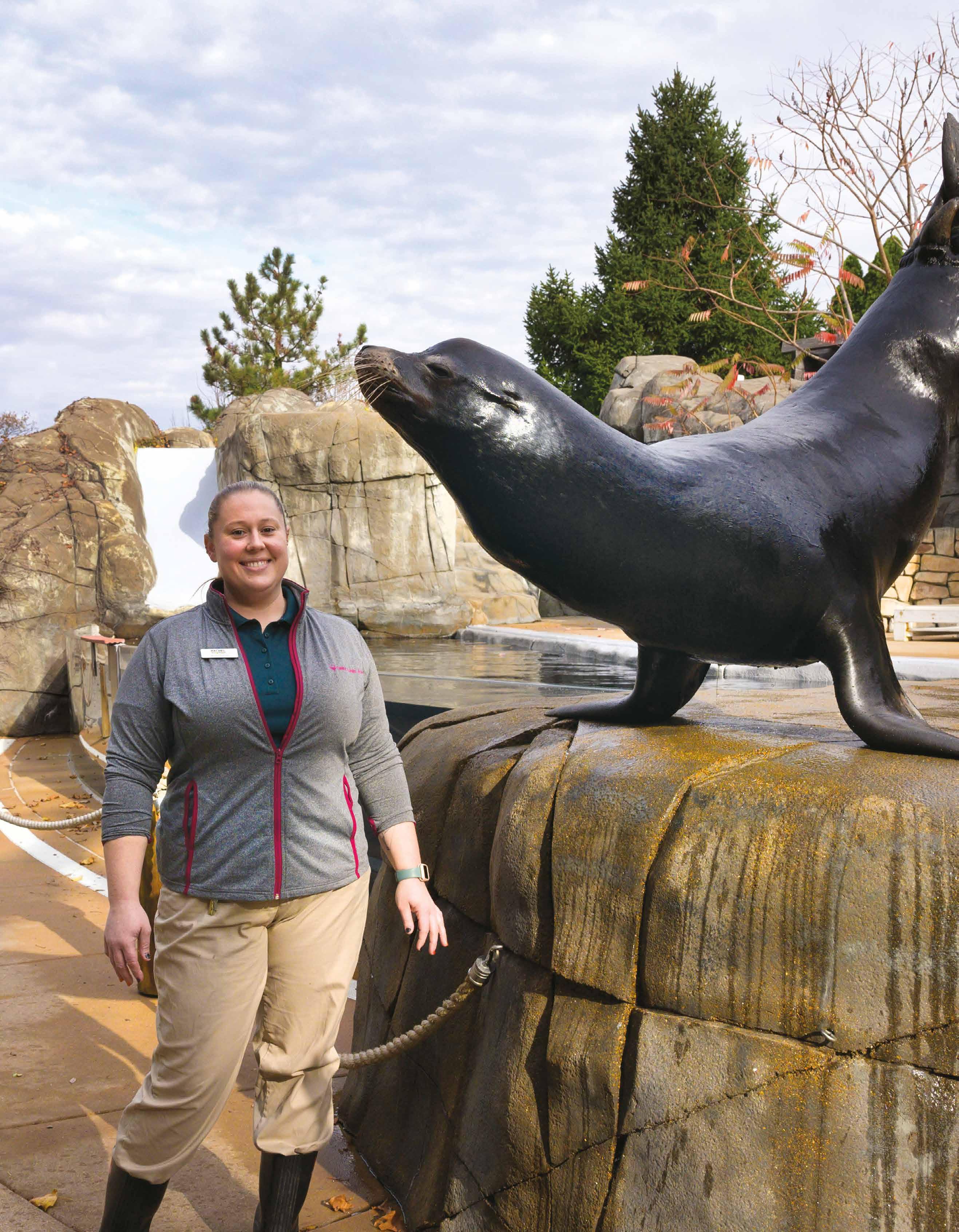
stlzoo 12
the CALL OF DUTY:
SWING KEePERS
BY REBECcA MCMILLER, MARKETING COMmUNICATIONS MANAGER PHOTOS BY RAY MEIBAUM
When your profession is caring for living beings, there is no true “day off.”
Someone always needs to ensure the individuals in their charge are healthy and have their needs met. But just like everyone — and perhaps even more so — caregivers need work-life balance and sometimes need to take extended leave.

What happens when the Saint Louis Zoo needs shifts covered for animal care? Bring in the swing keepers! The Zoo has three swing keepers: Rachel Koebert, Holly Simmons and Clare Stowe. While most keepers at the Zoo work in designated departments with specific focuses — such as carnivore, primate, invertebrate, ungulate, bird, amphibian/reptile, and animal nutrition departments — swing keepers rotate between all these areas, depending where they are needed. With their combined experience, they have worked in all animal departments.
Swing keepers cover for colleagues who are out for family
leave, illness or injury, or away from the Zoo conducting fieldwork. The COVID-19 pandemic increased the need for additional staffing; Koebert, Simmons and Stowe sometimes covered shifts for ill colleagues and covered additional shifts when animal care teams were split in two. (One team could continue working if the other team was exposed.) They could be with a team for a few days or for as long as a year.
“The goal is that we’re trained in every department, so if we need to transfer somewhere quickly, we get to work as soon as possible,” Koebert said. “This role keeps us on our toes; I really enjoy that about my job.”
13 Winter 2023
“THE GOAL IS THAT WE'RE TRAINED IN EVERY DEPARTMENT This roLe keEps us on our toes; i reaLLy enjoy that about my job.”
RacheL Koebert, SWING KEePER
LEFT: Swing KeEper RacheL Koebert works with Roby the CaLifornia sea Lion on his athLetic behaviors
LEARNING NEW HABITATS
MASTERING SAFETY PROTOCOLS BUILDING TRUST
Besides covering shifts for colleagues, a department sometimes needs additional help with animal care. Simmons noted that she worked in the elephant area after a birth because the team needed day and night shifts covered. And more help is often needed when a new habitat opens.
“When Michael and Quirsis Riney Primate Canopy Trails opened, we needed additional keepers to slowly introduce the animals to their new habitat,” Koebert said. “It was a well-coordinated process, and it was so interesting to see the animals’ personalities come out when presented with something so new.”
One of the biggest learning curves of working in a new area is mastering safety protocols. With 500 unique species at the Zoo, there are many different safety precautions, depending on the animal.
“Safety is paramount in caring for animals protocols are in place to keep us, the animals and guests safe,” Stowe said. “To name a few: There are ‘shifting procedures’ for when animals need to move between habitats.
There are lock
safety
protocols for larger animals like elephants, carnivores and apes. We must keep a minimum amount of feet away from certain safety barriers. We must wear masks and gloves when working with primates to prevent the spread of illness. And there are venomous reptile policies, including who can work with venomous animals and what to do in case of a bite or escape.”
Building trust is another unique aspect of their jobs. Some animals are wary of new people and are more comfortable with keepers with whom they have already built relationships.
“We ask the other keepers and managers a lot of questions and get to know an animal’s routine, including likes and dislikes,” Simmons said. “Some species are uncomfortable with eye contact or quick movement. Some may not like to shift [to another part of their habitat] through a particular door. I continue to ask questions as we get used to going through the routine together.”
Koebert noted that apes especially have very established trust with their
caretakers and usually take their time getting used to new team members.
“One of the gorillas likes to test the new or returning, in my case keepers. Sometimes he’ll do some grumbling, and other times he’ll toss around larger enrichment items to try and get a reaction out of you,” she said. “We are protected by safety barriers, of course, but even when you know it’s coming, it can be startling! It happens less often as you build the trust and relationship with him. We build this trust with positive reinforcement training sessions and by offering some of his favorite enrichment items!”
IS PARAMOUNT IN CARING FOR ANIMALS — PROTOCOLS ARE IN PLACE TO

stlzoo 14
“SAFETY
KEeP US, THE ANIMALS AND GUESTS SAFE.”
RIGHT: SWING KEePER CLARE STOWE HELPS DELIVER HAY TO THE ANTELOPE HOUSE
CLare stowe, SWING KEePER
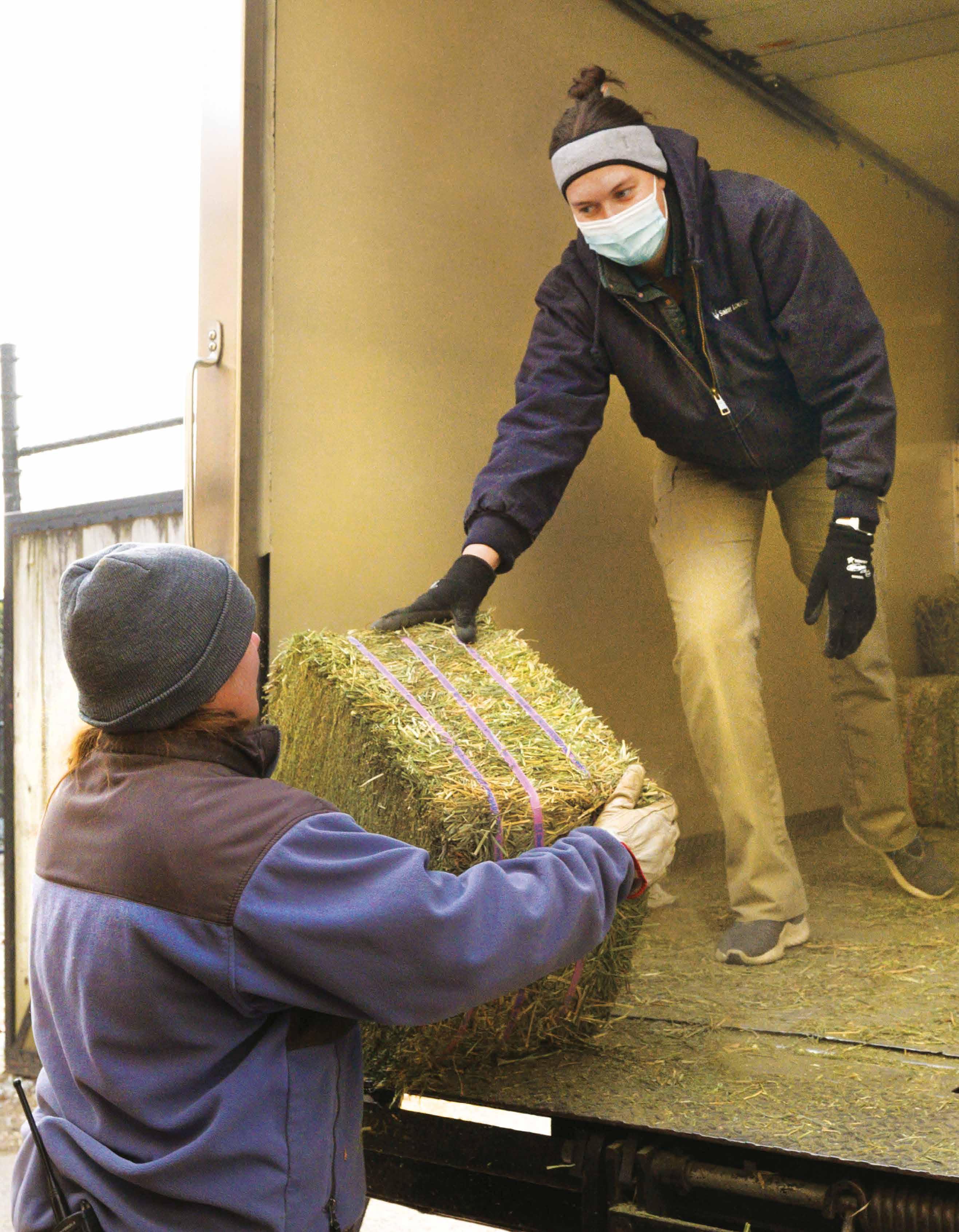

15 Winter 2023
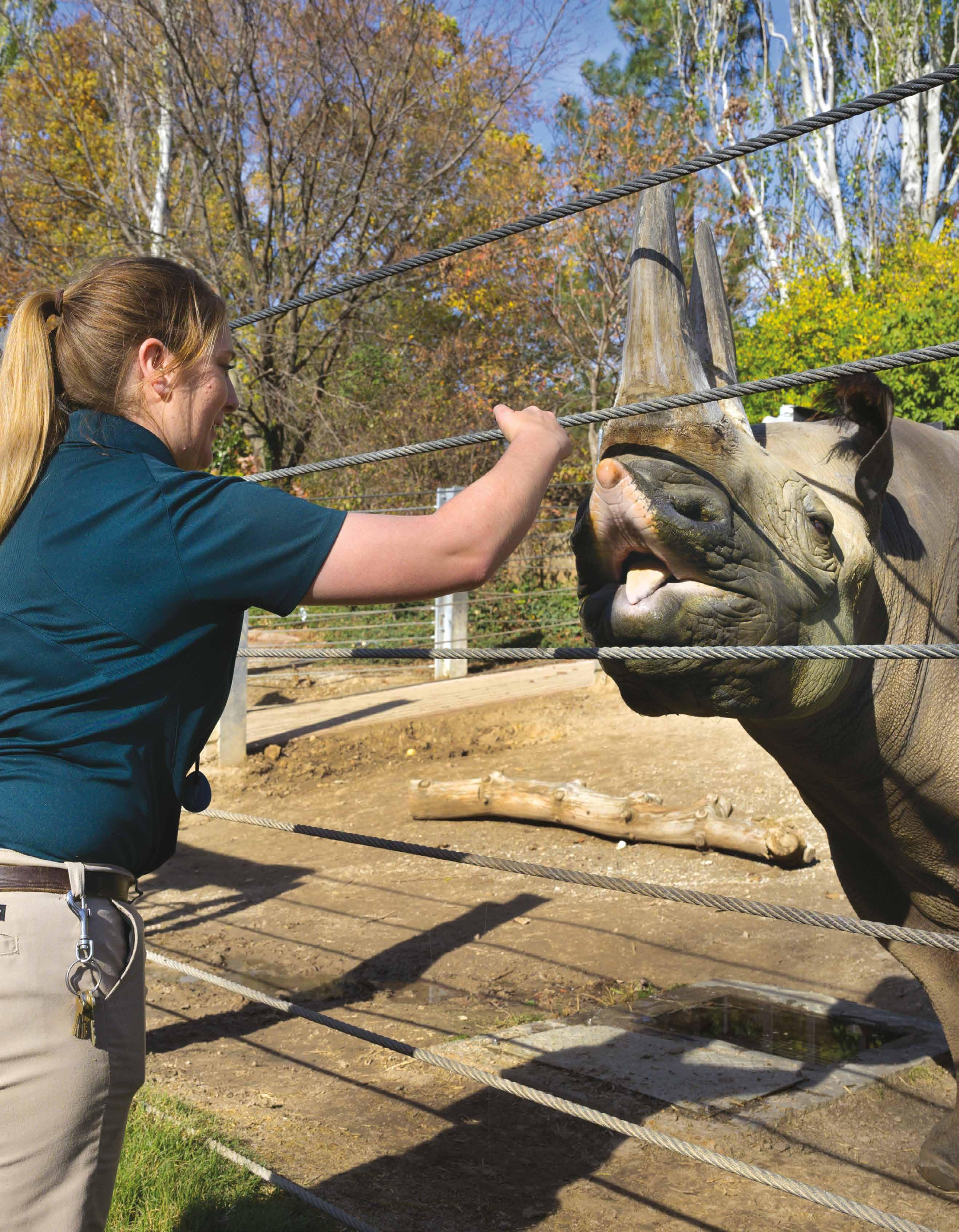
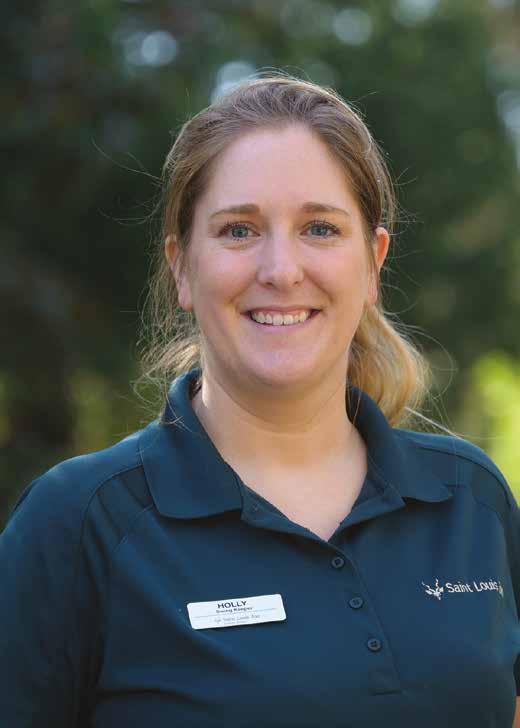
stlzoo 16
WITH TEAMWORK & DEDICATION
As swing keepers, their animal care skill sets are extensive.

“In my role, I’ve gained many new skills, including how to weigh a capybara, medicate a crowned crane, run sound for the Sea Lion Show and back up an all-terrain vehicle with a caddy full of elephant poop,” Simmons said.
“I’m proud of all I’ve learned on this job.”
Animal care is about teamwork, and all three swing keepers noted how much they’ve learned from their colleagues. They said keepers and managers invest time and take great care in training them, and they are very welcoming when they join a new team.
“One thing that always amazes us: A significant amount of time may pass before we return to an animal area.
But when we do, we’re impressed by how much a team learns and grows while we’re away. These are talented animal care professionals, and they only continue to get better,” Koebert said.
While many people want to know the swing keepers’ favorite animals, that is a hard one to peg — they have many! But they agreed on animals that are the most unique and challenge them as keepers: reptiles, primates and elephants.
“Animals at the Charles H. Hoessle Herpetarium are unique in that some aspects of their care are easier; most don’t need to eat every day, so diets are easier to manage,” Stowe said. “But these animals have specific temperature and lighting needs, which can be challenging. Some animals need to brumate, which is a natural period of inactivity that is triggered by cooling temperatures, and the animal care team needs to recreate those environmental conditions.”
They noted that elephants’ and primates’ size and intelligence make them incredible animals, but as keepers, they must plan and prepare for a long working day. Simmons loves caring for elephants but pointed out that it is a tough job.
“Caring for elephants definitely works your mind and body,” she said. “You must be creative when planning enrichment items for them
to enjoy — they are so strong and crush things easily. We also must prepare for their daily training and exercise sessions. And then there’s poop. They eat and poop a lot, so it takes heavy lifting to clean up after them.”
The field of animal care is competitive, especially for positions at organizations accredited by the Association of Zoos and Aquariums (like the Zoo). Our swing keepers’ advice for getting into the field is to take as many animal care-related opportunities as possible and be flexible.
“I’ve moved to five states for positions,” Koebert said. “There are only so many zoos, so if you want to be in this field, you may need to move. And you may need to be open to accepting internships and part-time roles before you find something full time.”
These keepers also agreed that, aside from animal care, the best part of the job is talking with guests. “We love talking to you!” Simmons said. “And please ask us all the questions; we enjoy talking about the animals we are privileged to work with.”
Although our swing keepers never know what one day to the next will look like, they love that aspect of their roles, and they are dedicated to ensuring all animals at the Zoo receive the best possible care. n
17 Winter 2023
“WE LOVE TALKING TO YOU! AND PLEASE ASK US ALL THE QUESTIONS; WE ENJOY TALKING ABOUT THE ANIMALS WE ARE PRIVILEGED TO WORK WITH.”
HOLLY SIMmONS, SWING KEePER
LEFT: Swing KeEper HoLLy SimMons CUES BLACK RHINOCEROS KATI RAIN FOR AN “OPEN” BEHAVIOR TO INSPECT HER MOUTH
Composting 101
Composting is one of the easiest ways we can help the planet, and it’s a great New Year’s resolution!
The Saint Louis Zoo sends 2.3 million pounds of animal waste, bedding and landscape material off for composting each year. There also are millions of pounds of food scraps sent for composting from eateries like Lakeside Cafe and Cafe Kudu. While this is a massive operation, you can do small-scale composting at home, which makes a big difference. Composting helps reduce methane, which is a significant contributor to global greenhouse gas emissions. Aside from environmental benefits, using compost material in your yard or garden can help plants grow, and it reduces odors in your home trash cans.
Are you interested in composting but don’t know where to begin? Here are the basics of what you need to know!

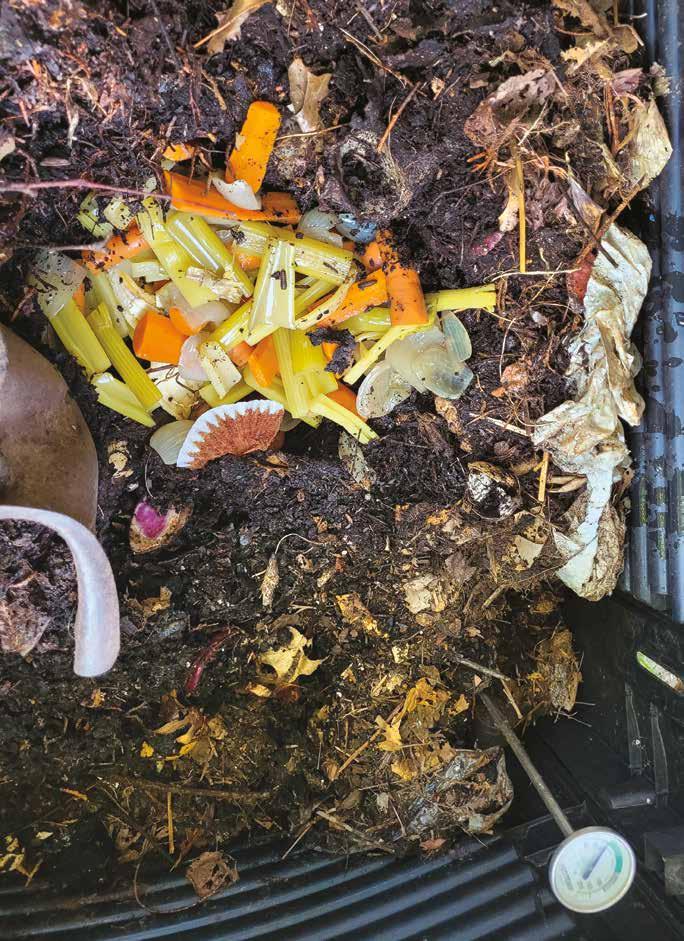
Getting Started
You’ll need a place to gather the scrap materials, which will eventually turn into compost. You can create a bin with used pallets or chicken wire, or you can purchase a compost bin or tumbler.
Next, you’ll need to gather materials to place in your bin. Composting material should include two components:
Greens: Greens are materials high in nitrogen. Examples include plant cuttings, fruit and vegetable waste, used coffee grounds and tea leaves.
Browns: Browns are materials high in carbon. Examples include sawdust, cornstalks, newspaper, cardboard, wood chips, straw and leaves.
Just like you prepare lasagna, layer the materials into your bin or pile so that no greens are exposed
at the top. Having greens at the top will attract wildlife to your bin, such as opossums, raccoons and rodents. Remember to keep greens covered as you add them into your bin or pile throughout the year.
Maintenance
You may choose to fill your bin or pile and then leave it alone throughout the year, allowing the microorganisms to break down the materials. This is called anaerobic composting. This process works fine, but it will take more time for the contents to break down, as opposed to aerobic composting. Aerobic composting requires maintenance of the bin or pile. Here are two best practices:
• As you add materials to your bin or pile throughout the year, add water to it. You don’t want the contents to be slimy; however,
stlzoo 18
Article and photos by Jason Ayran, Director of Workforce Development
A compost pile is started; greens and browns are layered into the pile
Invertebrates find a home in compost; they help break down the material
it should be about 40 to 50% moist. If you accidentally add too much water, don’t worry! Just add more brown materials.
• Using a pitchfork, turn the contents in your bin or pile, which will add oxygen.
Doing these two steps weekly will expedite the composting process. Having a compost thermometer will help you monitor the temperature in the middle. Conditions between 80 and 130 degrees Fahrenheit are ideal. As the temperature goes up, that means your pile is actively composting.
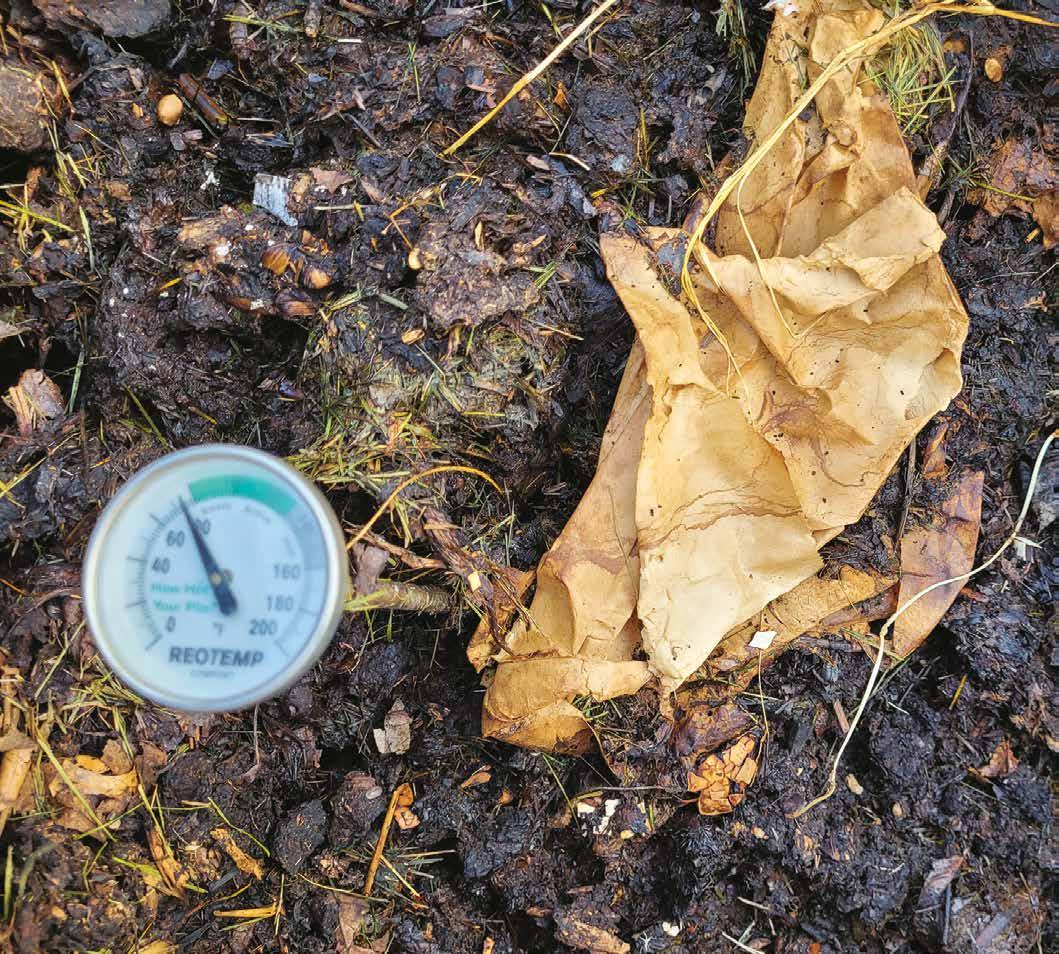
Over time, you’ll see some invertebrates make a home inside your bin or pile. These invertebrates are harmless, and they actually aid in breaking down the organic matter. You will see springtails, pill bugs, worms, millipedes,
centipedes, black soldier flies (and their larvae) and spiders.
Can I Start Composting in the Winter?
Winter is not too soon to begin composting. Even with the cooler temperatures, the microbes will still break down the contents, but at a slower rate. If you use a bin, consider adding cardboard and straw to the bottom and sides of the bin for insulation. Request used coffee grounds from your local coffee shop, and add them to your bin throughout the winter. The coffee grounds, which are high in nitrogen, will help keep your bin warm. Finally, ensure your bin is always full of contents.
The high volume of contents will help keep the bin warm.
The Final Product
How will you know that your compost is ready to use? It should crumble in your hands and smell earthy. If it does not feel or smell this way, it is not mature enough to apply. You’ll need to continue turning and watering the contents so the microbes and other invertebrates can finish the process.
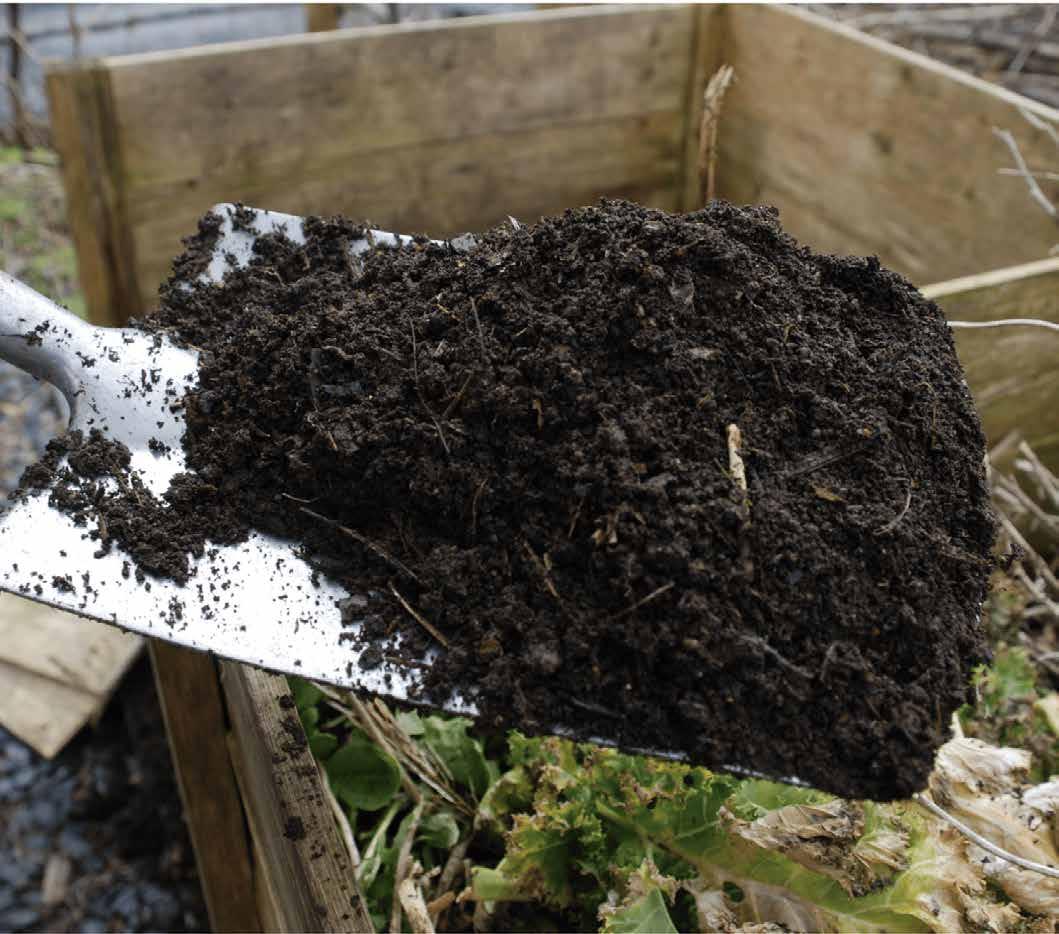
You don’t need to use a large amount of compost to reap the benefits. Sprinkle the compost on your flower and vegetable beds. For your lawn, simply rake in a quarter-inch layer in the fall.
If you’d like more resources on composting, check out the Missouri Department of Natural Resources website.
Best of luck on your composting journey! n
19 Winter 2023
A thermometer is placed in a compost pile for aerobic composting; the green range means the pile is actively composting (between 80 and 130 degrees Fahrenheit is ideal)
Fresh compost, ready to use in a yard or garden
Photo courtesy of Oregon State University Extension Catalog
10,000th Zoo-Raised Hellbender Released into the Wild
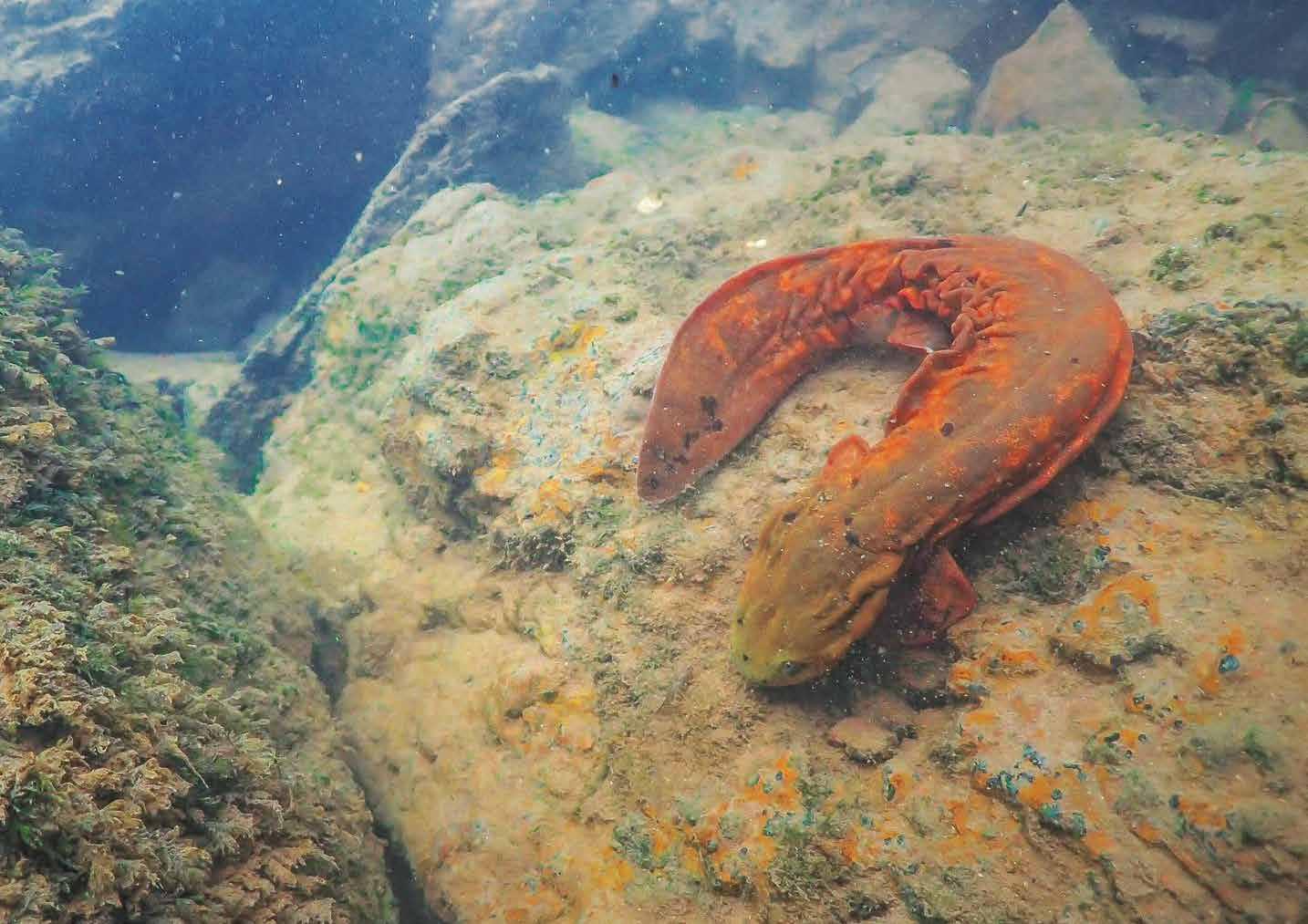
The Saint Louis Zoo’s Herpetology Department and the Ron and Karen Goellner Center for Hellbender Conservation, part of the Saint Louis Zoo WildCare Institute, celebrated an incredible milestone this past summer: The 10,000th Zoo-raised hellbender was released to the wilds of Missouri’s Ozark Plateau. This was a historic moment for our team and conservation partners; we take great pride in caring for this Missouri native.
Hellbenders, the largest species of amphibian in the U.S. and one of the largest in the world, are a fully aquatic salamander species. They rely on fast-flowing and heavily oxygenated rivers and streams to survive. These animals are at the top of the food chain in their habitat; the bulk of their diet is crayfish and small fish. They are a primitive amphibian species and have been part
of Missouri’s rivers for millions of years; however, due to a variety of factors, they are now at a high risk of extinction. Populations declined more than 70% over the last few decades.
We’ve come a long way since our release efforts began in 2008, and it’s thanks to the dedication of our team: Zoo staff as well as collaborating biologists from the Missouri Department of Conservation (MDC) and U.S. Fish and Wildlife Service (USFWS).
At the Zoo, we support thousands of hellbenders, both Ozark and eastern subspecies. They are bred and raised for release into the wild to help bolster wild populations. Our conservation facility dedicated to these animals includes three stream systems that replicate conditions of wild Ozark streams and hundreds
of smaller habitats used for rearing these special salamanders. Four fulltime keepers dedicate all their time to caring for hellbenders. The Zoo was the first institution to breed hellbenders in 2011 and has provided rearing protocols to other Association of Zoos and Aquariums organizations wishing to work with hellbenders.
We — Justin and Jeff — are proud to lead our Zoo’s hellbender conservation efforts. We’ve worked at the Zoo for over 10 years but are new to our leadership roles.
“I started my Zoo career caring for hellbenders; I was just starting college and began working at the Zoo on weekends to get hands-on experience in the world of conservation,” Justin said. “From a young age I wanted to do something in life to promote the conservation of wild animals and wild places. Hellbenders are some

stlzoo 20
By Jeff Dawson, Zoological Manager of Herpetology; and Justin Elden, Curator of Herpetology
An Ozark hellbender raised at the Saint Louis Zoo and released into the wild
Justin Elden, Curator of Herpetology; and Jeff Dawson, Zoological Manager of Herpetology
Photos by Ray Meibaum and the Center for Hellbender Conservation team
of the most fascinating animals on our planet. They have gone virtually unchanged for millennia, and the fact that they live in our own state and our waterways is unbelievable. They are essentially living fossils. It’s a shame that they’re on the brink of extinction, and I want to do everything within our power to ensure they’re here for millennia to come.”
Justin added that the day the 10,000th hellbender was returned to the wild was his first day as the Zoo’s Curator of Herpetology.
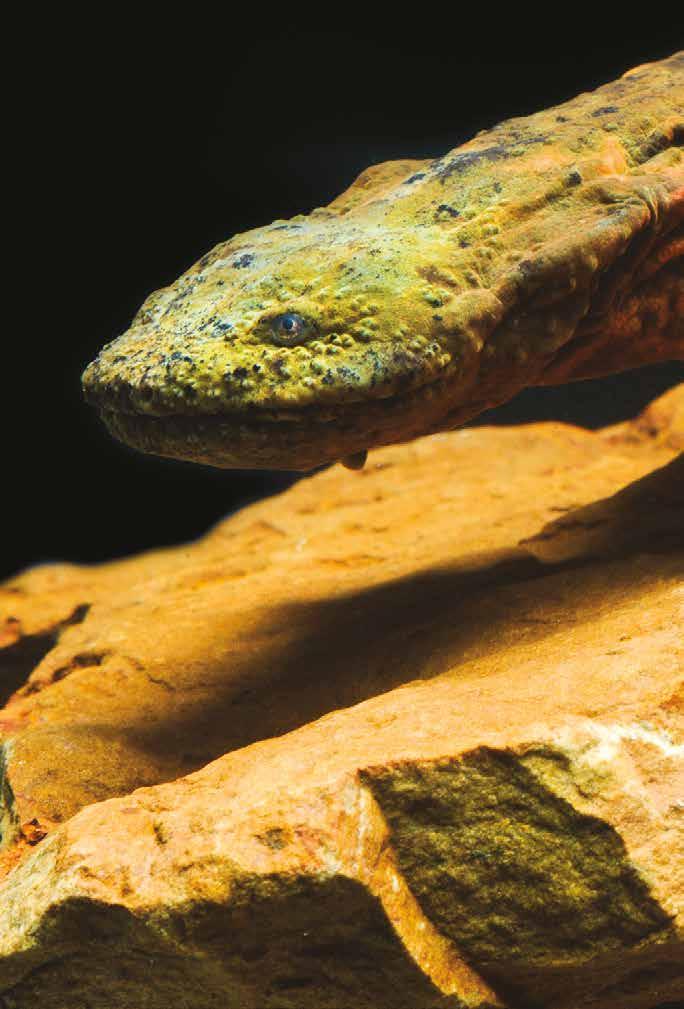
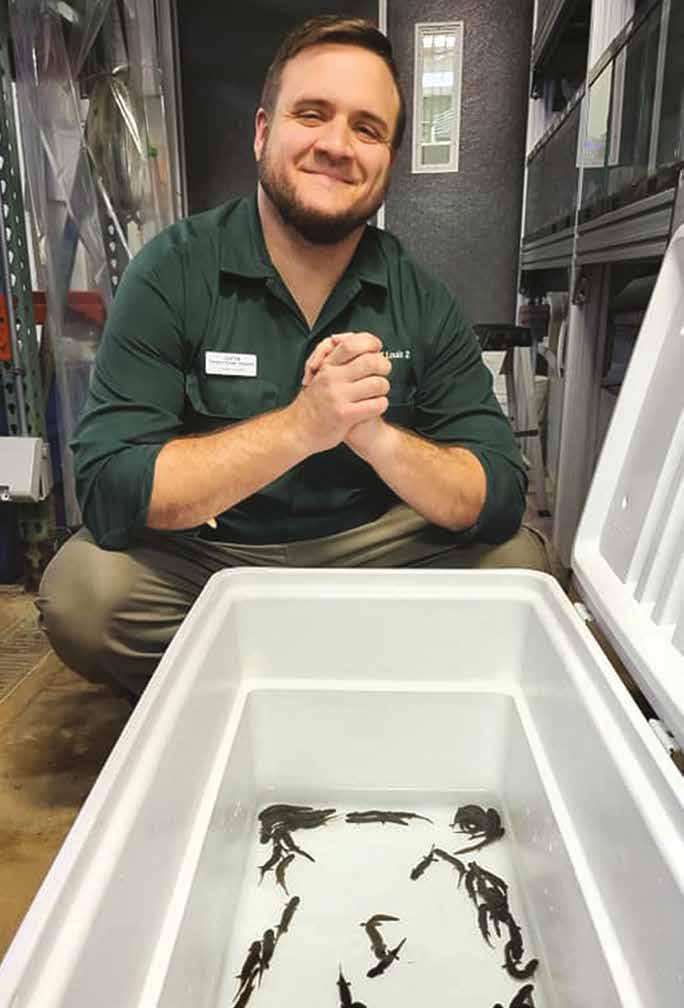
“I was inundated with memories of being a college student, hoping someday these animals would be on the mend,” he said. “It is an incredible honor to be a small part of this program and begin the next chapter of my career with this milestone.
To lead this charge with the remarkable keepers here at the Zoo and our friends in the MDC and USFWS is a dream come true. I’m absolutely confident we will save this species.”
Jeff agreed the team’s successful hellbender conservation efforts are a great source of pride.
“Our efforts are not only helping to restore hellbenders to the wild in Missouri, but our work also serves as a model for groups working on this species in other states,” he said. “Our hellbender keepers are incredibly talented and dedicated, and I’m pleased that I can support their efforts by managing the day-to-day operations of the center. I look forward to the many opportunities presented by my new
role at the Zoo, which includes increasing my personal involvement with hellbender conservation.”
Our team has become so successful at caring for both Ozark and eastern hellbenders that, to date, we have released 9,034 Ozark hellbenders and 1,172 eastern hellbenders into the wild, making this one of the most successful amphibian conservation programs in the world. These animals include first- and second-generation animals that have been bred in human care.
Though these animals are endangered, it is our hope that with time and dedication, we will save this species from extinction, allowing Missouri residents to live side by side with them for years to come. n
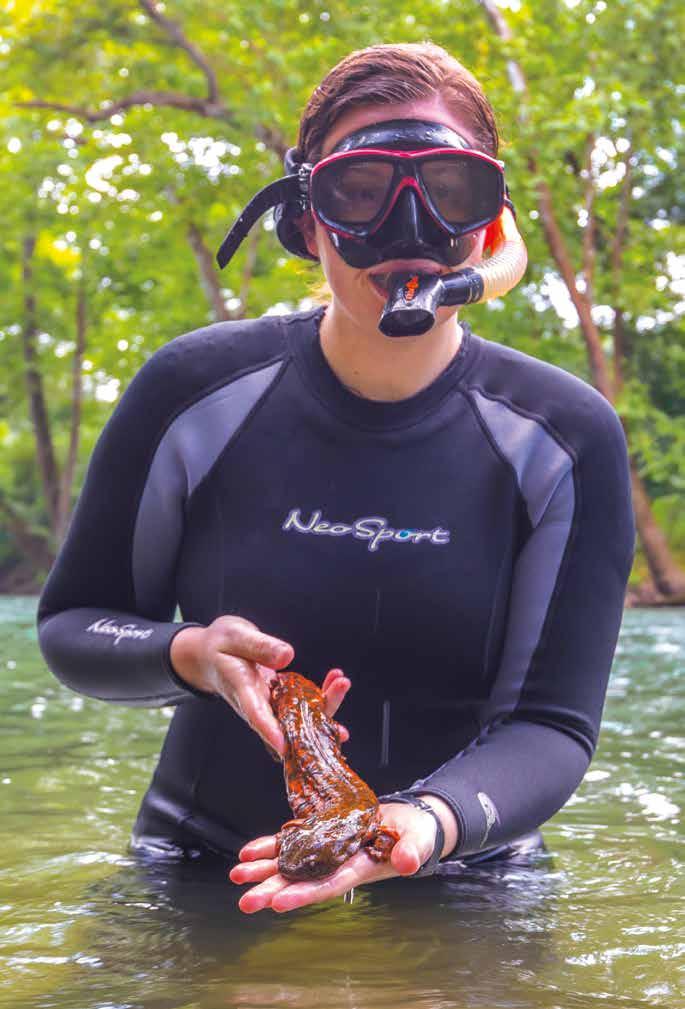
21 Winter 2023
Hellbender Keeper Patty Ihrig-Bueckendorf releases an Ozark hellbender into the wild
Curator of Herpetology Justin Elden and hellbenders being prepared for release
Ozark hellbender
happenings
present your member ID in person, or enter the promo code M844 if purchasing tickets online.
More information: slsc.org. Questions: (314) 289-4414.
Zoo Job Fairs
Jan. 28 and Feb. 3, 2023
9 a.m. – Noon in The Living World
Experience a fun, friendly and unique work environment with a job at the Zoo. Positions start at $13.25 but may increase based on experience and availability. More information: stlzoo.org/jobs.
Untamed Hearts: Valentine’s Day Dinner Feb. 10 and 11, 2023; McDonnell Center at River Camp
Save the date for the Zoo’s romantic valentine’s dinner! Treat your sweetie to an intimate evening at the Zoo. You will be served a three-course meal and wine. Limited reservations. Check back to stlzoo.org to learn more.

stlzoo 22
happenings
Sea Lion Show Spring Training
Emerson Dinoroarus Reopens March 17, 2023
The sea lions are back and reporting to spring training at the Judy and Jerry Kent Family Sea Lion Sound. The trainers are working with the intelligent pinnipeds on their athletic behaviors, including high dives and Children under age 2 are free. Check back to stlzoo.org for pricing
Throughout Dinoroarus, discover the amazing connections between dinosaurs and modern-day living animals while walking among 14 different groupings of animatronic and stationary dinosaurs. Zoo members: Included in member/premium member tickets. Children under age 2 are free.
Hours
Jan. 3 through March 3, 2023

10 a.m. to 4 p.m.
Mondays through Fridays* 9 a.m. to 4 p.m. Saturdays and Sundays, as well as Jan. 16 and Feb. 20
*On Mondays through Fridays from Jan. 3 through March 3 (excluding Jan. 16 and Feb. 20), guests will not be able to access the Zoo’s South Entrance on Wells Drive. This closure includes the South Welcome Desk, Rentals and Safari Gift Shop. Please park and enter the Zoo at the North Entrance on Government Drive.
Details subject to change. Please visit stlzoo.org for the latest information about Zoo events.

23 Winter 2023
Polar bear
A Sweet and Spooky Time: Marlin Perkins Society Night at Boo at the Zoo


 By Mary Kate Potrzeboski, Manager, Marlin Perkins Society
By Mary Kate Potrzeboski, Manager, Marlin Perkins Society
On behalf of the animals, staff and volunteers at the Saint Louis Zoo, we would like to extend our most sincere thanks to all of our Marlin Perkins Society members for their steadfast support. This special group of supporters is one of the Zoo’s most dedicated, and we were pleased to host another Marlin Perkins Society Night at Boo at the Zoo as a thank-you. This exclusive night at Boo at the Zoo presented by SSM Health Cardinal Glennon Children’s Hospital was held on Thursday, Oct. 13, and we welcomed over 1,900 members for a banner event! Guests wore fun, sometimes Zoo-themed costumes, enjoyed the special Howler beverage around Schnuck Family Plaza, and mingled with other Marlin Perkins Society members throughout the October evening. It is a delight to see members enjoying the holiday-themed lights and complimentary cookies and drinks. These nights are only a small thank-you for all that members do for the Zoo, but we hope that they know how important they are to the entire Zoo community. n
stlzoo 24
Great horned owl
Children enjoy the Pirate Post exhibit at Marlin Perkins Society Night at Boo at the Zoo
Marlin Perkins Society Night at Boo at the Zoo was a good time for all, big and small!
Zoo ALIVE Teens Take Conservation Action Virtual Honoring the Legacy of Joseph O. Losos
By Lori A. Sullivan, Director, Planned Gifts
“To say that Dad loved the Zoo would be an understatement,” daughter Louise Losos reflects. “As children, we spent our lives at the Zoo.”
Joe Losos’ enthusiasm was such that, in the early days of his involvement with the Saint Louis Zoo, he helped acquire a baby elephant that he had the privilege of naming after his wife, Carolyn. She was delighted because it positioned her as the petite Carolyn of the two! It wasn’t just elephants with whom he felt kinship. He always stopped by Siegfried the walrus to tickle his whiskers. He would jump at the opportunity to help carry flamingos into their
winter quarters. He was one of the Zoo’s most regular guests throughout his life.
Joe indeed loved the Zoo, giving his time as a volunteer leader for nearly 20 years. He served as a St. Louis Zoological Park Subdistrict commissioner and a Saint Louis Zoo Association Board member, being honored with emeritus status for each. Joe likewise supported the Zoo as a generous donor for more than 50 years.
Elephants and big cats were Joe’s favorite species because of their intelligence and majesty. He felt a special connection with jaguars, perhaps because he imagined
he had been one in an earlier life. Hence, the Joseph O. Losos Fund supports animal care for elephants and big cats, carrying forth his longtime support of them for generations to come. His endowed fund is a testament to the entire Losos family’s spirit of conservation that is deeply embedded in their values.

Following Joe’s passing in 2020 at age 89, the St. Louis Zoological Park Subdistrict Commission unanimously passed a resolution honoring him, recognizing his tremendous lifelong support and service to the Saint Louis Zoo and the broader St. Louis community. n

25 Winter 2023
Joe Losos with one of his beloved cats
Joe Losos and family enjoying the Emerson Zooline Railroad
Lintz Family Gift to Endowment Helps the Zoo Thrive for Generations
 By Robin Kraujalis, Manager, Planned Gifts
By Robin Kraujalis, Manager, Planned Gifts
The Lintz family’s relationship with the Saint Louis Zoo began when Rich and Kathy Lintz first moved to St. Louis from New York. Rich had just completed his MBA at Columbia Business School and was recruited for Anheuser-Busch’s executive training program. Their daughter Allie was 9 months old, and their son Chris was born soon after they arrived.
“Because the Zoo was fabulous, open almost every day, and free, we spent a lot of time there,” Rich remembered.
“It was our family tradition to go to the Zoo every Thanksgiving,” Kathy shared. “We have family from all around the country, and every time they visit, we take them to the Zoo.”
A few years later, Kathy was talking with neighbors about how much they loved the Zoo. One of them recruited her for the Zoo Friends Board (now the Saint Louis Zoo Association Board), where she served for years and eventually became involved in finance. As the founder of Matter Family Office, she and the financial consultants on her team “help families thrive for generations,” and that is her goal for the Zoo as well. In her more than 25 years of service as a volunteer and board member, Kathy has advocated for making the Zoo strong over the long term by investing wisely and creating, what is today, the Zoo Endowment.
Philanthropy is a family tradition, too. Rich, Kathy and their children

chose to invest in the Zoo, and in the Endowment in particular, because the Zoo is something they all treasure. They want to ensure the Zoo has the flexibility and strength to grow and thrive in the future.
Regarding their support of the Zoo, Kathy said, “Your gift [to the Zoo] is going to impact you, your community and your world in a way that few organizations can.”
Rich added, “One of the things the Zoo does is give us a perspective on the world, and our role in it. There are all these other creatures that share the planet with us, and we need to do more to take care of them. The Endowment provides a critical source of support for the important work that the Zoo does every day to care for and conserve animals, here and around the globe.” n
stlzoo 26
Lintz Family (left to right): Ross Mangin, Allie Mangin, Carsten Mangin, Rich Lintz, Warren Mangin, Kathy Lintz, Audrey Mangin, Chris Lintz, Cameron Lintz-Ngo, Ngoc Ngo
Sp rintoing Fu n
Whether you want to learn more about turtles, penguins, apes, sea lions or big cats, the Zoo has a program for you this spring! Our educational programs are designed for individuals of all ages and abilities. Together, we’ll make animal discoveries through unique Zoo experiences. And, Zoo members receive a discount on program fees!





We o
Program features may include: • Guided tours • Animal observations • Hands-on activities
er early childhood classes;
sessions
school breaks; family tours and overnight programs; and programs for adults,
at th e Sa i nt Lo u i s Zo o ! is open!
camp
during
scouts and youth groups. Registration
For program details, visit stlzoo.org/programs or call (314) 646-4544, option #6.
Marlin Perkins Society
The Saint Louis Zoo is extremely fortunate to have the support of more than 1,300 generous individuals, foundations and corporations through the Marlin Perkins Society. We welcome our newest members to the Society and thank them for joining this wonderful group of supporters. To our current members who have increased their financial support, we are pleased to recognize you as well. We are grateful for your commitment to our mission.
New Marlin Perkins Society Members
August 1 – October 31, 2022
Karen & Dennis Boone
Louise & Bob Bradshaw
Classic Aire Care
Pamela & Mark Cunningham
Perry D. Drake
Jackie & John Flotken
The Grisham Family
Richard Humphrey & Eileen Dunn Humphrey Sean & Kimberly James
Constance C. Kovach
Amy Lampert
Kate Larson
Rhonda & George Linne
The Manis Family Phil & Lois Poepsel
Rick & Christine Ratkowski
Monaca Rogers
Mary Jane & Jason Ruff
Zachary A. Smith
Karl Staser & Rachel Kyllo
Current Marlin Perkins Society Members Who Have Increased Support
August 1 – October 31, 2022
Anonymous – 3 Ben & Gwen Arenberg
Boyd & Pam Atteberry (10) Jared & Urmila Bauman Stephen G. Bell
Dr. Bill & Cindy Boever (10) Michael & Laura Bond Dennis & Karen Boone Rebekah & Shawn Briscoe
Paul Cambridge & Dr. Amanda Trudell
Central Bank of St. Louis (20) Carl & Jeanne Deutsch Foundation (15) Steven & Mary Frank Steven & Shelly Fuchs (10) Ms. Ruth A. Fuller
Robert & Susan Goldstein Family (15) Ted & Laurie Hellmuth (10) Jessica & Jacob Herschend
Dot & Larry LeGrand
Mrs. Peggy J. Mangiaforte
Dr.† & Mrs. Marshall S. Manne (20) Craig & Susan Mertz
David & Judith Meyer (10)
Ted & Linda Meyer
Vince & Jan Misuraca
Mr. Joseph M. Mount
Winthrop & Heidi Reed (15)
Dr. Charles & Dr. Elizabeth Schmitz (10)
Simons Jewelers (15)
Mr.† & Mrs. William A. Sippy (30) Ms. Sharon Sofian
William N. Stevens
Steven & Nikki Tudela Alan & Susie Wallach
(10) denotes member for at least 10 years (15) denotes member for at least 15 years (20) denotes member for at least 20 years (30) denotes member for at least 30 years
† denotes deceased
Please contact the Development Office at (314) 646-4859 if you:
• Would like information on how you can join or increase your support to the Marlin Perkins Society
• Discover a discrepancy or have a question (the Zoo makes every effort to acknowledge all gifts and to maintain accurate records)

28
Northern
pintail duck
Saint Louis Zoo Honor Roll
The following list represents new major and planned gifts and pledges, excluding Marlin Perkins Society and other membership gifts, made to the Saint Louis Zoo Association from August 1 to October 31, 2022. Donors are listed in the category of their most recent giving to the Saint Louis Zoo.
Major Gifts
$249,999 – 100,000
Carolyn Dearth & Family James S. McDonnell Family Foundation
The Anita & John O’Connell Family
Special Gifts
$99,999 – $50,000
Estate of Carolyn Lund
Lisa Mechele
Roger & Angela Zacher
$49,999 – $25,000
Anonymous Mrs. Janine S. Baker
Ann L. Case Stephany & Richard Kniep Ginny Smith, Kent Smith & Debbie Ferrari Mirian & Gabe Zacher Christopher Zacher
$24,999 – $10,000
Ms. Betty Beckmann
Leo R. Buder Foundation Trust
Chicago Zoological Society
Dr. Norman D. & Carolyn Kay Crecelius and Family Edward Chase Garvey Memorial Foundation
Estate of Judith Sutter Hinrichs
Estate of Lawrence & Alda McIntyre
John and Carolyn Peterson Charitable Foundation, Inc. Stone Hill Winery & Restaurant
$9,999 – $5,000
Anonymous Edison Family Foundation
Tony Holdener
Lemay Jefferson Barracks Lions Club
Barrie Somers
St. Augustine Alligator Farm Zoological Park
Mr. & Mrs. Robert M. Williams, Jr.
$4,999 – $1,000
Anonymous
Mr. & Mrs. Kenneth Balk
Anthony J. & Claire Bardol Patricia Bean
Earleen & Roger Duncan Engelhardt Family Foundation
Dr. & Mrs. Ted Garrett Linda Godsey
Marie Guariglia
The Hecker Family Mr. & Mrs. Ted Hellmuth H. Smith & Janet McGehee Ms. Lesley K. McIntire Mr. & Mrs. Ken Nettleton
Estate of Viola J. Reynolds Susan Sherman Mrs. William A. Sippy TBE Architects James & Jean Terry Michael Vanasco Mrs. Anne T. Weidmann Ms. Deborah K. Werner
$999 – $250
Dr. & Mrs. Jorge M. Alegre Jeannine M. & David Bardsley Mrs. Karen L. Condie
Missey Condie
Brian & Christy Cooke Mr. & Mrs. Raymond W. Costello, Jr. Michael Craft Mike & Sue Darcy
Mary Dollinger
Mr. John R. Drew Mr. Michael A. Fabrizi Mr. David C. Farrell Nicholas & Rita Hall
Patty & Bill Hickman
Amy Hines Charles & Marilyn Hoessle Ronald & Maribeth Hollon Mr. Patrick J. Kleaver John L. Koberg & Barbara A. Reed Dierdra Mister-Boyden Ashley Mudd
Tina Nord
Mr. & Mrs. James F. Nowicke Dr. & Mrs. Henry G. Ollinger
Roberta S. Poor Post Holdings
Mrs. Nancy Pruitt
Mr. Dan S. Recklein & Mrs. Beth A. Paulitsch Repertory Theatre of St. Louis Aileen Sarda Jane Shang Bruce & Greta Talen Curtis & Mindy Voelkel
Mr. & Mrs. John K. Wallace, Jr. Dr. & Mrs. Robert M. Waxler Charles & Patty Wiswall
The Saint Louis Zoo Development Office regrets any errors or omission of any gift.
If you would like to change your honor roll listing, contact Katie Meyers at meyers@stlzoo.org.
29 Winter 2023
Saint Louis Zoo Tribute Fund
Donors providing the Saint Louis Zoo Tribute Fund with gifts of $25 or more between August 1 and October 31, 2022, to honor or memorialize events and loved ones include:
In Memory Of Elizabeth Atkinson
Kathleen J. Birmes
Dr. & Mrs. Roger Dozier, DVM
Ms. Deborah Frenz
Wanda L. Hartman
Representative & Mrs. Ronald S. Holloway
Mary Alice Johnson
Rob & Joan Matthews
Model T Ford Club of Greater St. Louis
Mrs. Vickie S. O’Neil
Roberta S. Poor
Mr. & Mrs. Mark J. Rodell
Mr. & Mrs. James E. Swift
Mr. & Mrs. Stephen Ward
Ben Braley Marissa Williams
Barbara Bridgewater
Mr. & Mrs. Charles L. Barnes
Alexandra Bearman
Mr. & Mrs. Barry H. Beracha
Mrs. Van-Lear Black III
Arthur J. & Marie C. Brauer
Mr. Frank S. Childress
Mrs. Karen L. Condie
Ms. Missey Condie
Mrs. Lois M. Cook
Mrs. Donald Danforth, Jr. Mrs. Josephine Dietz
Sandra Dillard
Mr. & Mrs. Irl F. Engelhardt
Mr. & Mrs. J. Curtis Engler
Mr. Tim Ewing
Mr. David C. Farrell
Mr. & Mrs. Lucien R. Fouke, Jr.
Mr. & Mrs. Ronald K. Greenberg
Mr. Samuel B. & Mrs. Kathryn Hayes
Chris Imbs
Mr. & Mrs. Barry Y. Jackson
Mr. & Mrs. Charles N. McAlpin
Lisa & Kimball McMullin
Jennifer & Kent Rapp
Lawrence Reed
Repertory Theatre of St. Louis Andrew & Ivette Rothschild
Aileen Sarda
Jane Shang
Barbara S. Silverstein
Barrie Somers
Elizabeth Steffensen
Harriet K. Switzer
Mr. & Mrs. John K. Wallace, Jr.
David Bunt
Robert & Gail Mielziner
William P. Castle
Pam & Ray Briles
Jane C. Bucy Michael Craft
Barb Dowling & Laurie LeBoeuf Hilson Incorporated Laura Nikolaisen Dana Romeis
Ryan Crecelius
Dr. Norman D. & Carolyn Kay Crecelius and Family
Cali R. Cavicchi
Karrah Toth
Barbara A. Fiala
Anonymous
Kellisa & Mark Fiala Ms. Karan L. Onstott
Geri Wiele & Dana Charles Wiele Mrs. Carolyn E. Zornada
Ruth E. Freeman
Valerie Doud
Mr. & Mrs. Charles H. Hoessle Diane G. Senske
David P. Gast
Mr. Jeffrey L. Huntington
Ronald R. Goellner
Mr. & Mrs. Charles H. Hoessle
Ryan J. Haire
Jon Teske
Mary Hatty
Ms. Karen S. Kappel
Griffin D. Heiney
Michele Miller
Ursula Henson Ron & Carol Jablonski
Regina Hixon
Ms. Lisa A. Caplan Gary A. & Linda D. Hansen
Myron Holms
Kim J. Lancaster
Robert E. Hosenfelt
Christopher & Sharon Carlson Jon & Margaret Carlson Katherine A. Grant Mr. Robert H. Horas Jeanne Mueller Ms. Jane Riess Randye & Paul Scotti
Elizabeth Jablonski
Ron & Carol Jablonski
Wendy A. Knudsen
Harvey Greenstein
Caroline K. Loughlin
Mr. & Mrs. Charles H. Hoessle
Barbara J. Mappes
Brian & Christy Cooke James S. & Tracey L. Gans
Ellen Geraghty Jonathan & Sally King Cynthia McKibben
Mr. & Mrs. David C. Sadler
Phyllis M. Maritz
Mrs. Sally S. Lilly Mrs. Landsden McCandless, Jr.
Duane D. Mathis
Mr. Mark Ellebrecht
stlzoo 30
Scot McCreary
Miriam & Robert W. Butler
John Gilbert David McDowell
David Pratt
Donald & Victoria Reimler Elizabeth A. Vreeland
Robert L. Millman
Robert & Gail Mielziner
Travone Maurice Mister Jr. “TJ”
Ms. Kristin Anderson
Tina Bouska
Nikki Clark Maria C. Costello Lexi Ezell
Genevieve Hodges
Tymarie Hoffmann
Dierdra Mister-Boyden Mr. Tim Nickel
Georgia O’Brien
Mrs. Judith A. Roeslein
Cheryl L. Rossman
Christina L. Scranton
Chris Sorgani
Ms. Lynne A. Vance Chuck & Brenda Whitlow
Mlinzi
Laurie & Mauricio Velasquez
Marylynne S. Normile
John & Nancy Guilfoy Susan C. Koch
Mr. & Mrs. Paul Larson
MO Phi Chapter Alpha Delta Kappa Michael & Christine Normile Linda L. Smith
Peg Guilfoy Tyler
Karen Prebianca
Kathleen Mullen
Ann H. Rittenbaum
Lawrence Reed
Jerry E. Ritter
Michael T. & Patricia M. Abbene
Mr. & Mrs. Charles H. Hoessle Mr. Jeffrey L. Huntington
Stuart Schankman
Mr. & Mrs. David M. Aronson Bob & Susie Schulte
Florence M. Schreiter
Mrs. Marylyn A. Schiller
Nancy E. Siebern
James Hafer Ms. Anne L. Miller
Arthur L. Stepp Scott Genkinger
Jenny Hughes Johannes Liebnau Jeff Mehler Haribala N. Shah Garry Stepp
Louise Topp Terry Lohmeyer Lee R. Wallace Emily K. Crook Mr. David C. Farrell William C. Grubb Amy Hines Garrett Moseley Margaret Switzer Jeanine Vandevelde Terry Whittemore Meghan N. Wilkinson
Debra L. Watson Susan L. Caso-Bolnick
Mary L. Wittenberg
Susan M. Geile
The Gershman Family Greensfelder, Hemker & Gale, PC
Sharon A. Wyman
Jeannine M. & David Bardsley
Barbara S. Zeman
Rebecca Connell Nancy Schnuck Diemer Kathy Neal
In Honor Of Christopher & Krista Baucom Mosby Building Arts Ltd.
Jeffrey P. Bonner
Mr. & Mrs. Robert M. Williams, Jr.
Rebekah Gorinsky
B/N, B/K, M, D/T Matroni, Mobley, Rakes
Mrs. Ruth C. Hellstern Mr. & Mrs. Donald L. Hellstern
Tucker Holloran Tucker Holloran Joseph Lamb Michelle L. McLaughlin Bruce & Greta Talen
Cynthia Holter
Timothy & Cheryl Schaff
Mr. Jeffrey L. Huntington Lori A. Sullivan & G. Todd Rogan
Dr. Nicholas T. Kouchoukos Dr. & Mrs. Henry G. Ollinger
Zoey Mueller Jennifer & Ryan Franke Kimberly & James Sutton
Karita Musgrave Susan Sherman
Saint Louis Zoo Sales & Catering
Professional Tour Guide Assoc. of Metropolitan St. Louis
Lily Trautman Amy Robert
31 Winter 2023
DI RT

M A D E MY LU N C H ?
If you love to play in the dirt and help the planet, try composting!

WHAT IS COMPOSTING?

Composting turns food waste into plant food by returning nutrients to the dirt. It also keeps material out of landfills. Ask an adult to provide a compost bin, or you can make your own bin together together. (Adults can learn more on Page 18.)

stlzoo 32 ANSWERS: What
be
Pet
meat scraps, dairy products, cooking fats or grease, and bone scraps.
can’t
composted?
waste,








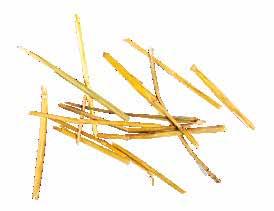






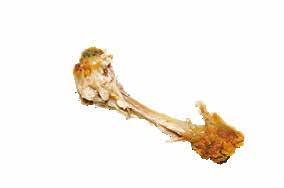



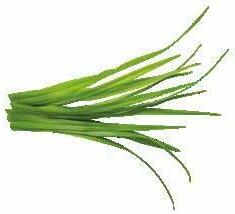
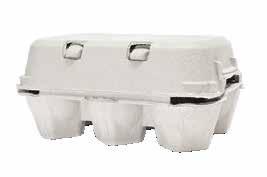
WHAT CAN’T BE COMPOSTED? Some items can’t be composted. Circle which items you think can’t go into compost, and check our answer key at the bottom. HAVE FUN, AND HAPPY COMPOSTING! Gather your compost lasagna ingredients: GREENS : Plant or Grass Cuttings, Fruit and Vegetable Waste, Used Coffee Grounds BROWNS : Sawdust, Newspaper, Cardboard, Leaves Create layers of greens and browns in a compost bin. Make sure the top of the bin is browns. This helps reduce raccoons and other backyard friends from getting into your compost bin. STEP 1 STEP 2 MAKE A “COMPOST LASAGNA!” lettuce bone scraps carrot peels weeds wood shavings pet waste grass clippings cooking fats or grease paper egg carton newspaper dairy products apple core meat scraps banana peel straw 33 Winter 2023

Address Service Requested C HECK IF APPROPRIATE: MY NAME IS MISSPELLED. MY ADDRESS IS INCORRECT. I RECEIVED MORE THAN ONE COPY. I NO LONGER WISH TO RECEIVE stlzoo Please clip this address panel and mail it to us, noting your request. Non-Profit Org. U.S. Postage P AID Saint Louis, MO Permit No. 2096 One Government Drive St. Louis, MO 63110 POSTMASTER: send address changes to stlzoo, Saint Louis Zoo, One Government Drive, St. Louis, MO 63110. © stlzoo, Saint Louis Zoo, 2023
Symbol of Changing Seasons Aleutian cackling geese fly overhead in a “V” formation. They go northbound in the spring and southbound in the fall. This is symbolic to many as a change of seasons.
Photo by Ray Meibaum
 The Lonely Hearts Club | Answering the Call of Duty: Swing Keepers | Composting 101
The Lonely Hearts Club | Answering the Call of Duty: Swing Keepers | Composting 101




















































 By Mary Kate Potrzeboski, Manager, Marlin Perkins Society
By Mary Kate Potrzeboski, Manager, Marlin Perkins Society


 By Robin Kraujalis, Manager, Planned Gifts
By Robin Kraujalis, Manager, Planned Gifts




























